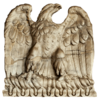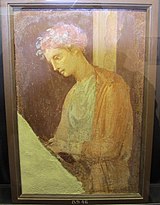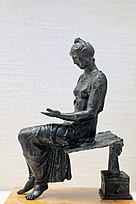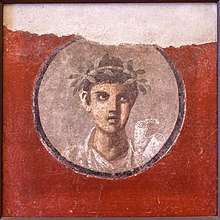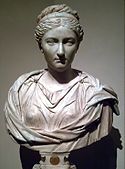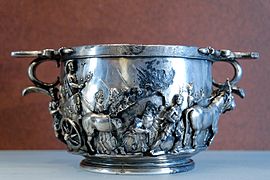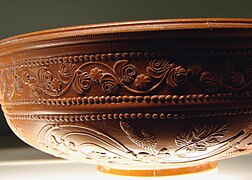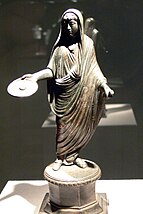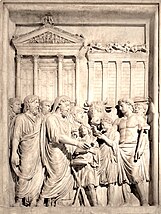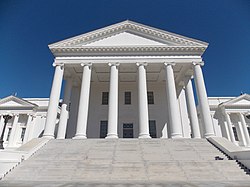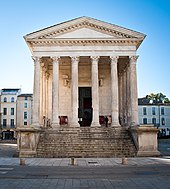Римская империя
Римская империя
| |||||||||||
|---|---|---|---|---|---|---|---|---|---|---|---|
| 27 г. до н. э. – 395 г. н. э. (единый) [1] 395–476/480 гг. н.э. ( Западный ) 395–1453 гг. н.э. ( Восточный ) | |||||||||||
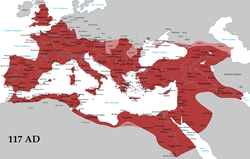 Roman Empire in AD 117 at its greatest extent, at the time of Trajan's death | |||||||||||
 Roman territorial evolution from the rise of the city-state of Rome to the fall of the Western Roman Empire | |||||||||||
| Capital |
| ||||||||||
| Common languages | |||||||||||
| Religion |
| ||||||||||
| Demonym(s) | Roman | ||||||||||
| Government | Semi-elective absolute monarchy (de facto) | ||||||||||
• Emperor | (List) | ||||||||||
| Historical era | Classical era to Late Middle Ages (Timeline) | ||||||||||
| Area | |||||||||||
| 25 BC[15] | 2,750,000 km2 (1,060,000 sq mi) | ||||||||||
| AD 117[15][16] | 5,000,000 km2 (1,900,000 sq mi) | ||||||||||
| AD 390[15] | 3,400,000 km2 (1,300,000 sq mi) | ||||||||||
| Population | |||||||||||
• 25 BC[17] | 56,800,000 | ||||||||||
| Currency | Sestertius,[e] aureus, solidus, nomisma | ||||||||||
| |||||||||||
Римская империя [а] было постреспубликанским государством Древнего Рима . Обычно понимается, что это означает период и территорию, которой правили римляне после того, как Октавиан принял единоличное правление в рамках принципата в 27 г. до н.э. Оно включало территории в Европе , Северной Африке и Передней Азии и управлялось императорами . Падение Западной Римской империи в 476 году нашей эры условно знаменует собой конец классической античности и начало Средневековья .
Рим распространил свое господство на большую часть Средиземноморья и за его пределы. Однако оно было серьезно дестабилизировано гражданскими войнами и политическими конфликтами , кульминацией которых стала победа Октавиана над Марком Антонием и Клеопатрой в битве при Акциуме в 31 г. до н.э. и последующее завоевание Птолемеевского царства в Египте. В 27 г. до н.э. сенат предоставил Октавиану верховную власть ( империум ) и новый титул Августа , ознаменовав его вступление на престол в качестве первого римского императора монархии римский с Римом в качестве единственной столицы. Обширные римские территории были организованы в сенаторские провинции, управляемые проконсулами, назначавшимися ежегодно по жребию, и имперские провинции, принадлежавшие императору, но управляемые легатами . [19]
The first two centuries of the Empire saw a period of unprecedented stability and prosperity known as the Pax Romana (lit. 'Roman Peace'). Rome reached its greatest territorial extent under Trajan (r. 98–117 AD); a period of increasing trouble and decline began under Commodus (180–192). In the 3rd century, the Empire underwent a crisis that threatened its existence, as the Gallic and Palmyrene Empires broke away from the Roman state, and a series of short-lived emperors led the Empire. It was reunified under Aurelian (r. 270–275). Diocletian set up two different imperial courts in the Greek East and Latin West in 286; Christians rose to power in the 4th century after the Edict of Milan. The imperial seat moved from Rome to Byzantium in 330, renamed Constantinople after Constantine the Great. The Migration Period, involving large invasions by Germanic peoples and by the Huns of Attila, led to the decline of the Western Roman Empire. With the fall of Ravenna to the Germanic Herulians and the deposition of Romulus Augustus in 476 AD by Odoacer, the Western Roman Empire finally collapsed. The Eastern Roman Empire survived for another millennium with Constantinople as its sole capital, until the city's fall in 1453.[f]
Due to the Empire's extent and endurance, its institutions and culture had a lasting influence on the development of language, religion, art, architecture, literature, philosophy, law, and forms of government across its territories. Latin evolved into the Romance languages while Medieval Greek became the language of the East. The Empire's adoption of Christianity resulted in the formation of medieval Christendom. Roman and Greek art had a profound impact on the Italian Renaissance. Rome's architectural tradition served as the basis for Romanesque, Renaissance and Neoclassical architecture, influencing Islamic architecture. The rediscovery of classical science and technology (which formed the basis for Islamic science) in medieval Europe contributed to the Scientific Renaissance and Scientific Revolution. Many modern legal systems, such as the Napoleonic Code, descend from Roman law. Rome's republican institutions have influenced the Italian city-state republics of the medieval period, the early United States, and modern democratic republics.
History
Transition from Republic to Empire
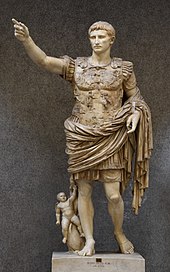
Rome had begun expanding shortly after the founding of the Roman Republic in the 6th century BC, though not outside the Italian peninsula until the 3rd century BC. Thus, it was an "empire" (a great power) long before it had an emperor.[21] The Republic was not a nation-state in the modern sense, but a network of self-ruled towns (with varying degrees of independence from the Senate) and provinces administered by military commanders. It was governed by annually elected magistrates (Roman consuls above all) in conjunction with the Senate.[22] The 1st century BC was a time of political and military upheaval, which ultimately led to rule by emperors.[23][24][25] The consuls' military power rested in the Roman legal concept of imperium, meaning "command" (though typically in a military sense).[26] Occasionally, successful consuls were given the honorary title imperator (commander); this is the origin of the word emperor, since this title was always bestowed to the early emperors.[27]
Rome suffered a long series of internal conflicts, conspiracies, and civil wars from the late second century BC (see Crisis of the Roman Republic) while greatly extending its power beyond Italy. In 44 BC Julius Caesar was briefly dictator before being assassinated. The faction of his assassins was driven from Rome and defeated at the Battle of Philippi in 42 BC by Mark Antony and Caesar's adopted son Octavian. Antony and Octavian's division of the Roman world did not last and Octavian's forces defeated those of Mark Antony and Cleopatra at the Battle of Actium in 31 BC. In 27 BC the Senate made Octavian princeps ("first citizen") with proconsular imperium, thus beginning the Principate (the first epoch of Roman imperial history, usually dated from 27 BC to 284 AD), and gave him the title Augustus ("the venerated"). Although the republic stood in name, Augustus had all meaningful authority.[28] Since his rule began an unprecedented period of peace and prosperity, he was so loved that he came to hold the power of a monarch de facto if not de jure. During the years of his rule, a new constitutional order emerged (in part organically and in part by design), so that, upon his death, this new constitutional order operated as before when Tiberius was accepted as the new emperor.[citation needed]
Pax Romana
The 200 years that began with Augustus's rule is traditionally regarded as the Pax Romana ("Roman Peace"). The cohesion of the empire was furthered by a degree of social stability and economic prosperity that Rome had never before experienced. Uprisings in the provinces were infrequent and put down "mercilessly and swiftly".[29] The success of Augustus in establishing principles of dynastic succession was limited by his outliving a number of talented potential heirs. The Julio-Claudian dynasty lasted for four more emperors—Tiberius, Caligula, Claudius, and Nero—before it yielded in 69 AD to the strife-torn Year of the Four Emperors, from which Vespasian emerged as victor. Vespasian became the founder of the brief Flavian dynasty, followed by the Nerva–Antonine dynasty which produced the "Five Good Emperors": Nerva, Trajan, Hadrian, Antoninus Pius, and Marcus Aurelius.[citation needed]
Transition from classical to late antiquity

In the view of contemporary Greek historian Cassius Dio, the accession of Commodus in 180 marked the descent "from a kingdom of gold to one of rust and iron",[30] a comment which has led some historians, notably Edward Gibbon, to take Commodus' reign as the beginning of the Empire's decline.[31][32]
In 212, during the reign of Caracalla, Roman citizenship was granted to all freeborn inhabitants of the empire. The Severan dynasty was tumultuous; an emperor's reign was ended routinely by his murder or execution and, following its collapse, the Empire was engulfed by the Crisis of the Third Century, a period of invasions, civil strife, economic disorder, and plague.[33] In defining historical epochs, this crisis sometimes marks the transition from Classical to Late Antiquity. Aurelian (r. 270–275) stabilised the empire militarily and Diocletian reorganised and restored much of it in 285.[34] Diocletian's reign brought the empire's most concerted effort against the perceived threat of Christianity, the "Great Persecution".[citation needed]
Diocletian divided the empire into four regions, each ruled by a separate tetrarch.[35] Confident that he fixed the disorder plaguing Rome, he abdicated along with his co-emperor, but the Tetrarchy collapsed shortly after. Order was eventually restored by Constantine the Great, who became the first emperor to convert to Christianity, and who established Constantinople as the new capital of the Eastern Empire. During the decades of the Constantinian and Valentinian dynasties, the empire was divided along an east–west axis, with dual power centres in Constantinople and Rome. Julian, who under the influence of his adviser Mardonius attempted to restore Classical Roman and Hellenistic religion, only briefly interrupted the succession of Christian emperors. Theodosius I, the last emperor to rule over both East and West, died in 395 after making Christianity the state religion.[36]


Fall in the West and survival in the East
The Western Roman Empire began to disintegrate in the early 5th century. The Romans were successful in fighting off all invaders, most famously Attila,[37] but the empire had assimilated so many Germanic peoples of dubious loyalty to Rome that the empire started to dismember itself.[38] Most chronologies place the end of the Western Roman Empire in 476, when Romulus Augustulus was forced to abdicate to the Germanic warlord Odoacer.[39][40][41]
Odoacer ended the Western Empire by declaring Zeno sole emperor and placing himself as Zeno's nominal subordinate. In reality, Italy was ruled by Odoacer alone.[39][40][42] The Eastern Roman Empire, called the Byzantine Empire by later historians, continued until the reign of Constantine XI Palaiologos. The last Roman emperor died in battle in 1453 against Mehmed II and his Ottoman forces during the siege of Constantinople. Mehmed II adopted the title of caesar in an attempt to claim a connection to the Empire.[43]
Geography and demography
The Roman Empire was one of the largest in history, with contiguous territories throughout Europe, North Africa, and the Middle East.[44] The Latin phrase imperium sine fine ("empire without end"[45]) expressed the ideology that neither time nor space limited the Empire. In Virgil's Aeneid, limitless empire is said to be granted to the Romans by Jupiter.[46] This claim of universal dominion was renewed when the Empire came under Christian rule in the 4th century.[g] In addition to annexing large regions, the Romans directly altered their geography, for example cutting down entire forests.[48]
Roman expansion was mostly accomplished under the Republic, though parts of northern Europe were conquered in the 1st century, when Roman control in Europe, Africa, and Asia was strengthened. Under Augustus, a "global map of the known world" was displayed for the first time in public at Rome, coinciding with the creation of the most comprehensive political geography that survives from antiquity, the Geography of Strabo.[49] When Augustus died, the account of his achievements (Res Gestae) prominently featured the geographical cataloguing of the Empire.[50] Geography alongside meticulous written records were central concerns of Roman Imperial administration.[51]

The Empire reached its largest expanse under Trajan (r. 98–117),[52] encompassing 5 million square kilometres.[15][16] The traditional population estimate of 55–60 million inhabitants[53] accounted for between one-sixth and one-fourth of the world's total population[54] and made it the most populous unified political entity in the West until the mid-19th century.[55] Recent demographic studies have argued for a population peak from 70 million to more than 100 million.[56] Each of the three largest cities in the Empire – Rome, Alexandria, and Antioch – was almost twice the size of any European city at the beginning of the 17th century.[57]
As the historian Christopher Kelly described it:
Then the empire stretched from Hadrian's Wall in drizzle-soaked northern England to the sun-baked banks of the Euphrates in Syria; from the great Rhine–Danube river system, which snaked across the fertile, flat lands of Europe from the Low Countries to the Black Sea, to the rich plains of the North African coast and the luxuriant gash of the Nile Valley in Egypt. The empire completely circled the Mediterranean ... referred to by its conquerors as mare nostrum—'our sea'.[53]
Trajan's successor Hadrian adopted a policy of maintaining rather than expanding the empire. Borders (fines) were marked, and the frontiers (limites) patrolled.[52] The most heavily fortified borders were the most unstable.[24] Hadrian's Wall, which separated the Roman world from what was perceived as an ever-present barbarian threat, is the primary surviving monument of this effort.[58]
Languages
Latin and Greek were the main languages of the Empire,[h] but the Empire was deliberately multilingual.[63] Andrew Wallace-Hadrill says "The main desire of the Roman government was to make itself understood".[64] At the start of the Empire, knowledge of Greek was useful to pass as educated nobility and knowledge of Latin was useful for a career in the military, government, or law.[65] Bilingual inscriptions indicate the everyday interpenetration of the two languages.[66]
Latin and Greek's mutual linguistic and cultural influence is a complex topic.[67] Latin words incorporated into Greek were very common by the early imperial era, especially for military, administration, and trade and commerce matters.[68] Greek grammar, literature, poetry and philosophy shaped Latin language and culture.[69][70]
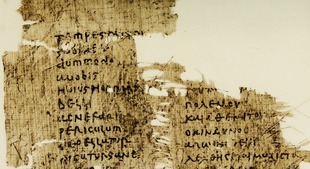
There was never a legal requirement for Latin in the Empire, but it represented a certain status.[72] High standards of Latin, Latinitas, started with the advent of Latin literature.[73] Due to the flexible language policy of the Empire, a natural competition of language emerged that spurred Latinitas, to defend Latin against the stronger cultural influence of Greek.[74] Over time Latin usage was used to project power and a higher social class.[75][76] Most of the emperors were bilingual but had a preference for Latin in the public sphere for political reasons, a "rule" that first started during the Punic Wars.[77] Different emperors up until Justinian would attempt to require the use of Latin in various sections of the administration but there is no evidence that a linguistic imperialism existed during the early Empire.[78]
After all freeborn inhabitants were universally enfranchised in 212, many Roman citizens would have lacked a knowledge of Latin.[79] The wide use of Koine Greek was what enabled the spread of Christianity and reflects its role as the lingua franca of the Mediterranean during the time of the Empire.[80] Following Diocletian's reforms in the 3rd century CE, there was a decline in the knowledge of Greek in the west.[81] Spoken Latin later fragmented into the incipient romance languages in the 7th century CE following the collapse of the Empire's west.[82]
The dominance of Latin and Greek among the literate elite obscure the continuity of other spoken languages within the Empire.[83] Latin, referred to in its spoken form as Vulgar Latin, gradually replaced Celtic and Italic languages.[84][85] References to interpreters indicate the continuing use of local languages, particularly in Egypt with Coptic, and in military settings along the Rhine and Danube. Roman jurists also show a concern for local languages such as Punic, Gaulish, and Aramaic in assuring the correct understanding of laws and oaths.[86] In Africa, Libyco-Berber and Punic were used in inscriptions into the 2nd century.[83] In Syria, Palmyrene soldiers used their dialect of Aramaic for inscriptions, an exception to the rule that Latin was the language of the military.[87] The last reference to Gaulish was between 560 and 575.[88][89] The emergent Gallo-Romance languages would then be shaped by Gaulish.[90] Proto-Basque or Aquitanian evolved with Latin loan words to modern Basque.[91] The Thracian language, as were several now-extinct languages in Anatolia, are attested in Imperial-era inscriptions.[80][83]
Society
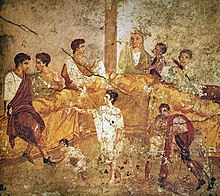
The Empire was remarkably multicultural, with "astonishing cohesive capacity" to create shared identity while encompassing diverse peoples.[93] Public monuments and communal spaces open to all—such as forums, amphitheatres, racetracks and baths—helped foster a sense of "Romanness".[94]
Roman society had multiple, overlapping social hierarchies.[95] The civil war preceding Augustus caused upheaval,[96] but did not effect an immediate redistribution of wealth and social power. From the perspective of the lower classes, a peak was merely added to the social pyramid.[97] Personal relationships—patronage, friendship (amicitia), family, marriage—continued to influence politics.[98] By the time of Nero, however, it was not unusual to find a former slave who was richer than a freeborn citizen, or an equestrian who exercised greater power than a senator.[99]
The blurring of the Republic's more rigid hierarchies led to increased social mobility,[100] both upward and downward, to a greater extent than all other well-documented ancient societies.[101] Women, freedmen, and slaves had opportunities to profit and exercise influence in ways previously less available to them.[102] Social life, particularly for those whose personal resources were limited, was further fostered by a proliferation of voluntary associations and confraternities (collegia and sodalitates): professional and trade guilds, veterans' groups, religious sodalities, drinking and dining clubs,[103] performing troupes,[104] and burial societies.[105]
Legal status
According to the jurist Gaius, the essential distinction in the Roman "law of persons" was that all humans were either free (liberi) or slaves (servi).[106] The legal status of free persons was further defined by their citizenship. Most citizens held limited rights (such as the ius Latinum, "Latin right"), but were entitled to legal protections and privileges not enjoyed by non-citizens. Free people not considered citizens, but living within the Roman world, were peregrini, non-Romans.[107] In 212, the Constitutio Antoniniana extended citizenship to all freeborn inhabitants of the empire. This legal egalitarianism required a far-reaching revision of existing laws that distinguished between citizens and non-citizens.[108]
Women in Roman law
Right: Bronze statuette (1st century AD) of a young woman reading, based on a Hellenistic original
Freeborn Roman women were considered citizens, but did not vote, hold political office, or serve in the military. A mother's citizen status determined that of her children, as indicated by the phrase ex duobus civibus Romanis natos ("children born of two Roman citizens").[i] A Roman woman kept her own family name (nomen) for life. Children most often took the father's name, with some exceptions.[111] Women could own property, enter contracts, and engage in business.[112] Inscriptions throughout the Empire honour women as benefactors in funding public works, an indication they could hold considerable fortunes.[113]
The archaic manus marriage in which the woman was subject to her husband's authority was largely abandoned by the Imperial era, and a married woman retained ownership of any property she brought into the marriage. Technically she remained under her father's legal authority, even though she moved into her husband's home, but when her father died she became legally emancipated.[114] This arrangement was a factor in the degree of independence Roman women enjoyed compared to many other cultures up to the modern period:[115] although she had to answer to her father in legal matters, she was free of his direct scrutiny in daily life,[116] and her husband had no legal power over her.[117] Although it was a point of pride to be a "one-man woman" (univira) who had married only once, there was little stigma attached to divorce, nor to speedy remarriage after being widowed or divorced.[118] Girls had equal inheritance rights with boys if their father died without leaving a will.[119] A mother's right to own and dispose of property, including setting the terms of her will, gave her enormous influence over her sons into adulthood.[120]

As part of the Augustan programme to restore traditional morality and social order, moral legislation attempted to regulate conduct as a means of promoting "family values". Adultery was criminalized,[121] and defined broadly as an illicit sex act (stuprum) between a male citizen and a married woman, or between a married woman and any man other than her husband. That is, a double standard was in place: a married woman could have sex only with her husband, but a married man did not commit adultery if he had sex with a prostitute or person of marginalized status.[122] Childbearing was encouraged: a woman who had given birth to three children was granted symbolic honours and greater legal freedom (the ius trium liberorum).[123]
Slaves and the law
At the time of Augustus, as many as 35% of the people in Roman Italy were slaves,[124] making Rome one of five historical "slave societies" in which slaves constituted at least a fifth of the population and played a major role in the economy.[j][124] Slavery was a complex institution that supported traditional Roman social structures as well as contributing economic utility.[125] In urban settings, slaves might be professionals such as teachers, physicians, chefs, and accountants; the majority of slaves provided trained or unskilled labour. Agriculture and industry, such as milling and mining, relied on the exploitation of slaves. Outside Italy, slaves were on average an estimated 10 to 20% of the population, sparse in Roman Egypt but more concentrated in some Greek areas. Expanding Roman ownership of arable land and industries affected preexisting practices of slavery in the provinces.[126] Although slavery has often been regarded as waning in the 3rd and 4th centuries, it remained an integral part of Roman society until gradually ceasing in the 6th and 7th centuries with the disintegration of the complex Imperial economy.[127]
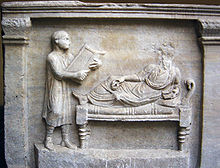
Laws pertaining to slavery were "extremely intricate".[128] Slaves were considered property and had no legal personhood. They could be subjected to forms of corporal punishment not normally exercised on citizens, sexual exploitation, torture, and summary execution. A slave could not as a matter of law be raped; a slave's rapist had to be prosecuted by the owner for property damage under the Aquilian Law.[129] Slaves had no right to the form of legal marriage called conubium, but their unions were sometimes recognized.[130] Technically, a slave could not own property,[131] but a slave who conducted business might be given access to an individual fund (peculium) that he could use, depending on the degree of trust and co-operation between owner and slave.[132] Within a household or workplace, a hierarchy of slaves might exist, with one slave acting as the master of others.[133] Talented slaves might accumulate a large enough peculium to justify their freedom, or be manumitted for services rendered. Manumission had become frequent enough that in 2 BC a law (Lex Fufia Caninia) limited the number of slaves an owner was allowed to free in his will.[134]
Following the Servile Wars of the Republic, legislation under Augustus and his successors shows a driving concern for controlling the threat of rebellions through limiting the size of work groups, and for hunting down fugitive slaves.[135] Over time slaves gained increased legal protection, including the right to file complaints against their masters. A bill of sale might contain a clause stipulating that the slave could not be employed for prostitution, as prostitutes in ancient Rome were often slaves.[136] The burgeoning trade in eunuchs in the late 1st century prompted legislation that prohibited the castration of a slave against his will "for lust or gain".[137]
Roman slavery was not based on race.[138] Generally, slaves in Italy were indigenous Italians,[139] with a minority of foreigners (including both slaves and freedmen) estimated at 5% of the total in the capital at its peak, where their number was largest. Foreign slaves had higher mortality and lower birth rates than natives, and were sometimes even subjected to mass expulsions.[140] The average recorded age at death for the slaves of the city of Rome was seventeen and a half years (17.2 for males; 17.9 for females).[141]
During the period of republican expansionism when slavery had become pervasive, war captives were a main source of slaves. The range of ethnicities among slaves to some extent reflected that of the armies Rome defeated in war, and the conquest of Greece brought a number of highly skilled and educated slaves. Slaves were also traded in markets and sometimes sold by pirates. Infant abandonment and self-enslavement among the poor were other sources.[142] Vernae, by contrast, were "homegrown" slaves born to female slaves within the household, estate or farm. Although they had no special legal status, an owner who mistreated or failed to care for his vernae faced social disapproval, as they were considered part of the family household and in some cases might actually be the children of free males in the family.[143]
Freedmen

Rome differed from Greek city-states in allowing freed slaves to become citizens; any future children of a freedman were born free, with full rights of citizenship. After manumission, a slave who had belonged to a Roman citizen enjoyed active political freedom (libertas), including the right to vote.[144] His former master became his patron (patronus): the two continued to have customary and legal obligations to each other.[145][146] A freedman was not entitled to hold public office or the highest state priesthoods, but could play a priestly role. He could not marry a woman from a senatorial family, nor achieve legitimate senatorial rank himself, but during the early Empire, freedmen held key positions in the government bureaucracy, so much so that Hadrian limited their participation by law.[146] The rise of successful freedmen—through political influence or wealth—is a characteristic of early Imperial society. The prosperity of a high-achieving group of freedmen is attested by inscriptions throughout the Empire, and by their ownership of some of the most lavish houses at Pompeii.[citation needed]
Census rank
The Latin word ordo (plural ordines) is translated variously and inexactly into English as "class, order, rank". One purpose of the Roman census was to determine the ordo to which an individual belonged. The two highest ordines in Rome were the senatorial and equestrian.[citation needed] Outside Rome, the decurions, also known as curiales, were the top governing ordo of an individual city.[citation needed]
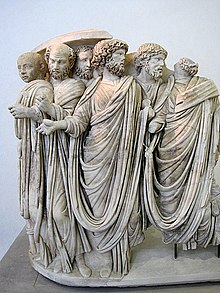
"Senator" was not itself an elected office in ancient Rome; an individual gained admission to the Senate after he had been elected to and served at least one term as an executive magistrate. A senator also had to meet a minimum property requirement of 1 million sestertii.[147] Not all men who qualified for the ordo senatorius chose to take a Senate seat, which required legal domicile at Rome. Emperors often filled vacancies in the 600-member body by appointment.[148] A senator's son belonged to the ordo senatorius, but he had to qualify on his own merits for admission to the Senate. A senator could be removed for violating moral standards.[149]
In the time of Nero, senators were still primarily from Italy, with some from the Iberian peninsula and southern France; men from the Greek-speaking provinces of the East began to be added under Vespasian.[150] The first senator from the easternmost province, Cappadocia, was admitted under Marcus Aurelius.[k] By the Severan dynasty (193–235), Italians made up less than half the Senate.[152] During the 3rd century, domicile at Rome became impractical, and inscriptions attest to senators who were active in politics and munificence in their homeland (patria).[149]
Senators were the traditional governing class who rose through the cursus honorum, the political career track, but equestrians often possessed greater wealth and political power. Membership in the equestrian order was based on property; in Rome's early days, equites or knights had been distinguished by their ability to serve as mounted warriors, but cavalry service was a separate function in the Empire.[l] A census valuation of 400,000 sesterces and three generations of free birth qualified a man as an equestrian.[154] The census of 28 BC uncovered large numbers of men who qualified, and in 14 AD, a thousand equestrians were registered at Cádiz and Padua alone.[m][156] Equestrians rose through a military career track (tres militiae) to become highly placed prefects and procurators within the Imperial administration.[157]
The rise of provincial men to the senatorial and equestrian orders is an aspect of social mobility in the early Empire. Roman aristocracy was based on competition, and unlike later European nobility, a Roman family could not maintain its position merely through hereditary succession or having title to lands.[158] Admission to the higher ordines brought distinction and privileges, but also responsibilities. In antiquity, a city depended on its leading citizens to fund public works, events, and services (munera). Maintaining one's rank required massive personal expenditures.[159] Decurions were so vital for the functioning of cities that in the later Empire, as the ranks of the town councils became depleted, those who had risen to the Senate were encouraged to return to their hometowns, in an effort to sustain civic life.[160]
In the later Empire, the dignitas ("worth, esteem") that attended on senatorial or equestrian rank was refined further with titles such as vir illustris ("illustrious man").[161] The appellation clarissimus (Greek lamprotatos) was used to designate the dignitas of certain senators and their immediate family, including women.[162] "Grades" of equestrian status proliferated.[163]
Unequal justice
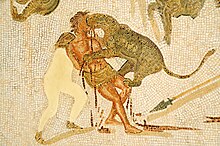
As the republican principle of citizens' equality under the law faded, the symbolic and social privileges of the upper classes led to an informal division of Roman society into those who had acquired greater honours (honestiores) and humbler folk (humiliores). In general, honestiores were the members of the three higher "orders", along with certain military officers.[164] The granting of universal citizenship in 212 seems to have increased the competitive urge among the upper classes to have their superiority affirmed, particularly within the justice system.[165] Sentencing depended on the judgment of the presiding official as to the relative "worth" (dignitas) of the defendant: an honestior could pay a fine for a crime for which an humilior might receive a scourging.[166]
Execution, which was an infrequent legal penalty for free men under the Republic,[167] could be quick and relatively painless for honestiores, while humiliores might suffer the kinds of torturous death previously reserved for slaves, such as crucifixion and condemnation to the beasts.[168] In the early Empire, those who converted to Christianity could lose their standing as honestiores, especially if they declined to fulfil religious responsibilities, and thus became subject to punishments that created the conditions of martyrdom.[169]
Government and military

The three major elements of the Imperial state were the central government, the military, and the provincial government.[170] The military established control of a territory through war, but after a city or people was brought under treaty, the mission turned to policing: protecting Roman citizens, agricultural fields, and religious sites.[171] The Romans lacked sufficient manpower or resources to rule through force alone. Cooperation with local elites was necessary to maintain order, collect information, and extract revenue. The Romans often exploited internal political divisions.[172]
Communities with demonstrated loyalty to Rome retained their own laws, could collect their own taxes locally, and in exceptional cases were exempt from Roman taxation. Legal privileges and relative independence incentivized compliance.[173] Roman government was thus limited, but efficient in its use of available resources.[174]
Central government
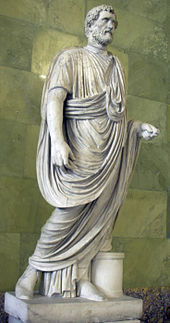
The Imperial cult of ancient Rome identified emperors and some members of their families with divinely sanctioned authority (auctoritas). The rite of apotheosis (also called consecratio) signified the deceased emperor's deification.[175] The dominance of the emperor was based on the consolidation of powers from several republican offices.[176] The emperor made himself the central religious authority as pontifex maximus, and centralized the right to declare war, ratify treaties, and negotiate with foreign leaders.[177] While these functions were clearly defined during the Principate, the emperor's powers over time became less constitutional and more monarchical, culminating in the Dominate.[178]
The emperor was the ultimate authority in policy- and decision-making, but in the early Principate, he was expected to be accessible and deal personally with official business and petitions. A bureaucracy formed around him only gradually.[179] The Julio-Claudian emperors relied on an informal body of advisors that included not only senators and equestrians, but trusted slaves and freedmen.[180] After Nero, the influence of the latter was regarded with suspicion, and the emperor's council (consilium) became subject to official appointment for greater transparency.[181] Though the Senate took a lead in policy discussions until the end of the Antonine dynasty, equestrians played an increasingly important role in the consilium.[182] The women of the emperor's family often intervened directly in his decisions.[183]
Access to the emperor might be gained at the daily reception (salutatio), a development of the traditional homage a client paid to his patron; public banquets hosted at the palace; and religious ceremonies. The common people who lacked this access could manifest their approval or displeasure as a group at games.[184] By the 4th century, the Christian emperors became remote figureheads who issued general rulings, no longer responding to individual petitions.[185] Although the Senate could do little short of assassination and open rebellion to contravene the will of the emperor, it retained its symbolic political centrality.[186] The Senate legitimated the emperor's rule, and the emperor employed senators as legates (legati): generals, diplomats, and administrators.[187]
The practical source of an emperor's power and authority was the military. The legionaries were paid by the Imperial treasury, and swore an annual oath of loyalty to the emperor.[188] Most emperors chose a successor, usually a close family member or adopted heir. The new emperor had to seek a swift acknowledgement of his status and authority to stabilize the political landscape. No emperor could hope to survive without the allegiance of the Praetorian Guard and the legions. To secure their loyalty, several emperors paid the donativum, a monetary reward. In theory, the Senate was entitled to choose the new emperor, but did so mindful of acclamation by the army or Praetorians.[189]
Military
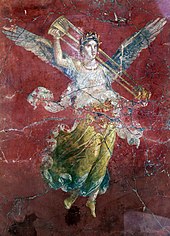

After the Punic Wars, the Roman army comprised professional soldiers who volunteered for 20 years of active duty and five as reserves. The transition to a professional military began during the late Republic and was one of the many profound shifts away from republicanism, under which an army of conscript citizens defended the homeland against a specific threat. The Romans expanded their war machine by "organizing the communities that they conquered in Italy into a system that generated huge reservoirs of manpower for their army".[190] By Imperial times, military service was a full-time career.[191] The pervasiveness of military garrisons throughout the Empire was a major influence in the process of Romanization.[192]
The primary mission of the military of the early empire was to preserve the Pax Romana.[193] The three major divisions of the military were:
- the garrison at Rome, comprising the Praetorian Guard, the cohortes urbanae and the vigiles, who functioned as police and firefighters;
- the provincial army, comprising the Roman legions and the auxiliaries provided by the provinces (auxilia);
- the navy.

Through his military reforms, which included consolidating or disbanding units of questionable loyalty, Augustus regularized the legion. A legion was organized into ten cohorts, each of which comprised six centuries, with a century further made up of ten squads (contubernia); the exact size of the Imperial legion, which was likely determined by logistics, has been estimated to range from 4,800 to 5,280.[194] After Germanic tribes wiped out three legions in the Battle of the Teutoburg Forest in 9 AD, the number of legions was increased from 25 to around 30.[195] The army had about 300,000 soldiers in the 1st century, and under 400,000 in the 2nd, "significantly smaller" than the collective armed forces of the conquered territories. No more than 2% of adult males living in the Empire served in the Imperial army.[196] Augustus also created the Praetorian Guard: nine cohorts, ostensibly to maintain the public peace, which were garrisoned in Italy. Better paid than the legionaries, the Praetorians served only sixteen years.[197]
The auxilia were recruited from among the non-citizens. Organized in smaller units of roughly cohort strength, they were paid less than the legionaries, and after 25 years of service were rewarded with Roman citizenship, also extended to their sons. According to Tacitus[198] there were roughly as many auxiliaries as there were legionaries—thus, around 125,000 men, implying approximately 250 auxiliary regiments.[199] The Roman cavalry of the earliest Empire were primarily from Celtic, Hispanic or Germanic areas. Several aspects of training and equipment derived from the Celts.[200]
The Roman navy not only aided in the supply and transport of the legions but also in the protection of the frontiers along the rivers Rhine and Danube. Another duty was protecting maritime trade against pirates. It patrolled the Mediterranean, parts of the North Atlantic coasts, and the Black Sea. Nevertheless, the army was considered the senior and more prestigious branch.[201]
Provincial government
An annexed territory became a Roman province in three steps: making a register of cities, taking a census, and surveying the land.[202] Further government recordkeeping included births and deaths, real estate transactions, taxes, and juridical proceedings.[203] In the 1st and 2nd centuries, the central government sent out around 160 officials annually to govern outside Italy.[22] Among these officials were the Roman governors: magistrates elected at Rome who in the name of the Roman people governed senatorial provinces; or governors, usually of equestrian rank, who held their imperium on behalf of the emperor in imperial provinces, most notably Roman Egypt.[204] A governor had to make himself accessible to the people he governed, but he could delegate various duties.[205] His staff, however, was minimal: his official attendants (apparitores), including lictors, heralds, messengers, scribes, and bodyguards; legates, both civil and military, usually of equestrian rank; and friends who accompanied him unofficially.[205]
Other officials were appointed as supervisors of government finances.[22] Separating fiscal responsibility from justice and administration was a reform of the Imperial era, to avoid provincial governors and tax farmers exploiting local populations for personal gain.[206] Equestrian procurators, whose authority was originally "extra-judicial and extra-constitutional", managed both state-owned property and the personal property of the emperor (res privata).[205] Because Roman government officials were few, a provincial who needed help with a legal dispute or criminal case might seek out any Roman perceived to have some official capacity.[207]
Law
Roman courts held original jurisdiction over cases involving Roman citizens throughout the empire, but there were too few judicial functionaries to impose Roman law uniformly in the provinces. Most parts of the Eastern Empire already had well-established law codes and juridical procedures.[96] Generally, it was Roman policy to respect the mos regionis ("regional tradition" or "law of the land") and to regard local laws as a source of legal precedent and social stability.[96][208] The compatibility of Roman and local law was thought to reflect an underlying ius gentium, the "law of nations" or international law regarded as common and customary.[209] If provincial law conflicted with Roman law or custom, Roman courts heard appeals, and the emperor held final decision-making authority.[96][208][n]
In the West, law had been administered on a highly localized or tribal basis, and private property rights may have been a novelty of the Roman era, particularly among Celts. Roman law facilitated the acquisition of wealth by a pro-Roman elite.[96] The extension of universal citizenship to all free inhabitants of the Empire in 212 required the uniform application of Roman law, replacing local law codes that had applied to non-citizens. Diocletian's efforts to stabilize the Empire after the Crisis of the Third Century included two major compilations of law in four years, the Codex Gregorianus and the Codex Hermogenianus, to guide provincial administrators in setting consistent legal standards.[210]
The pervasiveness of Roman law throughout Western Europe enormously influenced the Western legal tradition, reflected by continued use of Latin legal terminology in modern law.[citation needed]
Taxation
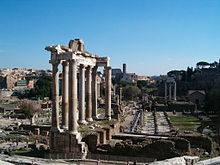
Taxation under the Empire amounted to about 5% of its gross product.[211] The typical tax rate for individuals ranged from 2 to 5%.[212] The tax code was "bewildering" in its complicated system of direct and indirect taxes, some paid in cash and some in kind. Taxes might be specific to a province, or kinds of properties such as fisheries; they might be temporary.[213] Tax collection was justified by the need to maintain the military,[214] and taxpayers sometimes got a refund if the army captured a surplus of booty.[215] In-kind taxes were accepted from less-monetized areas, particularly those who could supply grain or goods to army camps.[216]
The primary source of direct tax revenue was individuals, who paid a poll tax and a tax on their land, construed as a tax on its produce or productive capacity.[212] Tax obligations were determined by the census: each head of household provided a headcount of his household, as well as an accounting of his property.[217] A major source of indirect-tax revenue was the portoria, customs and tolls on trade, including among provinces.[212] Towards the end of his reign, Augustus instituted a 4% tax on the sale of slaves,[218] which Nero shifted from the purchaser to the dealers, who responded by raising their prices.[219] An owner who manumitted a slave paid a "freedom tax", calculated at 5% of value.[o] An inheritance tax of 5% was assessed when Roman citizens above a certain net worth left property to anyone outside their immediate family. Revenues from the estate tax and from an auction tax went towards the veterans' pension fund (aerarium militare).[212]
Low taxes helped the Roman aristocracy increase their wealth, which equalled or exceeded the revenues of the central government. An emperor sometimes replenished his treasury by confiscating the estates of the "super-rich", but in the later period, the resistance of the wealthy to paying taxes was one of the factors contributing to the collapse of the Empire.[54]
Economy

The Empire is best thought of as a network of regional economies, based on a form of "political capitalism" in which the state regulated commerce to assure its own revenues.[220] Economic growth, though not comparable to modern economies, was greater than that of most other societies prior to industrialization.[221] Territorial conquests permitted a large-scale reorganization of land use that resulted in agricultural surplus and specialization, particularly in north Africa.[222] Some cities were known for particular industries. The scale of urban building indicates a significant construction industry.[222] Papyri preserve complex accounting methods that suggest elements of economic rationalism,[222] and the Empire was highly monetized.[223] Although the means of communication and transport were limited in antiquity, transportation in the 1st and 2nd centuries expanded greatly, and trade routes connected regional economies.[224] The supply contracts for the army drew on local suppliers near the base (castrum), throughout the province, and across provincial borders.[225]Economic historians vary in their calculations of the gross domestic product during the Principate.[226] In the sample years of 14, 100, and 150 AD, estimates of per capita GDP range from 166 to 380 HS. The GDP per capita of Italy is estimated as 40[227] to 66%[228] higher than in the rest of the Empire, due to tax transfers from the provinces and the concentration of elite income.
Economic dynamism resulted in social mobility. Although aristocratic values permeated traditional elite society, wealth requirements for rank indicate a strong tendency towards plutocracy. Prestige could be obtained through investing one's wealth in grand estates or townhouses, luxury items, public entertainments, funerary monuments, and religious dedications. Guilds (collegia) and corporations (corpora) provided support for individuals to succeed through networking.[164] "There can be little doubt that the lower classes of ... provincial towns of the Roman Empire enjoyed a high standard of living not equaled again in Western Europe until the 19th century".[229] Households in the top 1.5% of income distribution captured about 20% of income. The "vast majority" produced more than half of the total income, but lived near subsistence.[230]
Currency and banking


The early Empire was monetized to a near-universal extent, using money as a way to express prices and debts.[232] The sestertius (English "sesterces", symbolized as HS) was the basic unit of reckoning value into the 4th century,[233] though the silver denarius, worth four sesterces, was also used beginning in the Severan dynasty.[234] The smallest coin commonly circulated was the bronze as, one-tenth denarius.[235] Bullion and ingots seem not to have counted as pecunia ("money") and were used only on the frontiers. Romans in the first and second centuries counted coins, rather than weighing them—an indication that the coin was valued on its face. This tendency towards fiat money led to the debasement of Roman coinage in the later Empire.[236] The standardization of money throughout the Empire promoted trade and market integration.[232] The high amount of metal coinage in circulation increased the money supply for trading or saving.[237]Rome had no central bank, and regulation of the banking system was minimal. Banks of classical antiquity typically kept less in reserves than the full total of customers' deposits. A typical bank had fairly limited capital, and often only one principal. Seneca assumes that anyone involved in Roman commerce needs access to credit.[236] A professional deposit banker received and held deposits for a fixed or indefinite term, and lent money to third parties. The senatorial elite were involved heavily in private lending, both as creditors and borrowers.[238] The holder of a debt could use it as a means of payment by transferring it to another party, without cash changing hands. Although it has sometimes been thought that ancient Rome lacked documentary transactions, the system of banks throughout the Empire permitted the exchange of large sums without physically transferring coins, in part because of the risks of moving large amounts of cash. Only one serious credit shortage is known to have occurred in the early Empire, in 33 AD;[239] generally, available capital exceeded the amount needed by borrowers.[236] The central government itself did not borrow money, and without public debt had to fund deficits from cash reserves.[240]
Emperors of the Antonine and Severan dynasties debased the currency, particularly the denarius, under the pressures of meeting military payrolls.[233] Sudden inflation under Commodus damaged the credit market.[236] In the mid-200s, the supply of specie contracted sharply.[233] Conditions during the Crisis of the Third Century—such as reductions in long-distance trade, disruption of mining operations, and the physical transfer of gold coinage outside the empire by invading enemies—greatly diminished the money supply and the banking sector.[233][236] Although Roman coinage had long been fiat money or fiduciary currency, general economic anxieties came to a head under Aurelian, and bankers lost confidence in coins. Despite Diocletian's introduction of the gold solidus and monetary reforms, the credit market of the Empire never recovered its former robustness.[236]
Mining and metallurgy
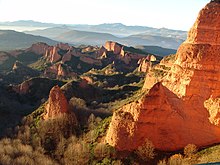
The main mining regions of the Empire were the Iberian Peninsula (silver, copper, lead, iron and gold);[241] Gaul (gold, silver, iron);[242] Britain (mainly iron, lead, tin),[243] the Danubian provinces (gold, iron);[244] Macedonia and Thrace (gold, silver); and Asia Minor (gold, silver, iron, tin). Intensive large-scale mining—of alluvial deposits, and by means of open-cast mining and underground mining—took place from the reign of Augustus up to the early 3rd century, when the instability of the Empire disrupted production.[citation needed]
Hydraulic mining allowed base and precious metals to be extracted on a proto-industrial scale.[245] The total annual iron output is estimated at 82,500 tonnes.[246] Copper and lead production levels were unmatched until the Industrial Revolution.[247][248][249][250] At its peak around the mid-2nd century, the Roman silver stock is estimated at 10,000 t, five to ten times larger than the combined silver mass of medieval Europe and the Caliphate around 800 AD.[249][251] As an indication of the scale of Roman metal production, lead pollution in the Greenland ice sheet quadrupled over prehistoric levels during the Imperial era and dropped thereafter.[252]
Transportation and communication

The Empire completely encircled the Mediterranean, which they called "our sea" (Mare Nostrum).[253] Roman sailing vessels navigated the Mediterranean as well as major rivers.[57] Transport by water was preferred where possible, as moving commodities by land was more difficult.[254] Vehicles, wheels, and ships indicate the existence of a great number of skilled woodworkers.[255]
Land transport utilized the advanced system of Roman roads, called "viae". These roads were primarily built for military purposes,[256] but also served commercial ends. The in-kind taxes paid by communities included the provision of personnel, animals, or vehicles for the cursus publicus, the state mail and transport service established by Augustus.[216] Relay stations were located along the roads every seven to twelve Roman miles, and tended to grow into villages or trading posts.[257] A mansio (plural mansiones) was a privately run service station franchised by the imperial bureaucracy for the cursus publicus. The distance between mansiones was determined by how far a wagon could travel in a day.[257] Carts were usually pulled by mules, travelling about 4 mph.[258]
Trade and commodities
Roman provinces traded among themselves, but trade extended outside the frontiers to regions as far away as China and India.[259] Chinese trade was mostly conducted overland through middle men along the Silk Road; Indian trade also occurred by sea from Egyptian ports. The main commodity was grain.[260] Also traded were olive oil, foodstuffs, garum (fish sauce), slaves, ore and manufactured metal objects, fibres and textiles, timber, pottery, glassware, marble, papyrus, spices and materia medica, ivory, pearls, and gemstones.[261] Though most provinces could produce wine, regional varietals were desirable and wine was a central trade good.[262]
Labour and occupations

Inscriptions record 268 different occupations in Rome and 85 in Pompeii.[196] Professional associations or trade guilds (collegia) are attested for a wide range of occupations, some quite specialized.[164]
Work performed by slaves falls into five general categories: domestic, with epitaphs recording at least 55 different household jobs; imperial or public service; urban crafts and services; agriculture; and mining. Convicts provided much of the labour in the mines or quarries, where conditions were notoriously brutal.[263] In practice, there was little division of labour between slave and free,[96] and most workers were illiterate and without special skills.[264] The greatest number of common labourers were employed in agriculture: in Italian industrial farming (latifundia), these may have been mostly slaves, but elsewhere slave farm labour was probably less important.[96]
Textile and clothing production was a major source of employment. Both textiles and finished garments were traded and products were often named for peoples or towns, like a fashion "label".[265] Better ready-to-wear was exported by local businessmen (negotiatores or mercatores).[266] Finished garments might be retailed by their sales agents, by vestiarii (clothing dealers), or peddled by itinerant merchants.[266] The fullers (fullones) and dye workers (coloratores) had their own guilds.[267] Centonarii were guild workers who specialized in textile production and the recycling of old clothes into pieced goods.[p]

Architecture and engineering
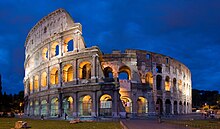
The chief Roman contributions to architecture were the arch, vault and dome. Some Roman structures still stand today, due in part to sophisticated methods of making cements and concrete.[270] Roman temples developed Etruscan and Greek forms, with some distinctive elements. Roman roads are considered the most advanced built until the early 19th century. The system of roadways facilitated military policing, communications, and trade, and were resistant to floods and other environmental hazards. Some remained usable for over a thousand years.[citation needed]
Roman bridges were among the first large and lasting bridges, built from stone (and in most cases concrete) with the arch as the basic structure. The largest Roman bridge was Trajan's bridge over the lower Danube, constructed by Apollodorus of Damascus, which remained for over a millennium the longest bridge to have been built.[271] The Romans built many dams and reservoirs for water collection, such as the Subiaco Dams, two of which fed the Anio Novus, one of the largest aqueducts of Rome.[272]

The Romans constructed numerous aqueducts. De aquaeductu, a treatise by Frontinus, who served as water commissioner, reflects the administrative importance placed on the water supply. Masonry channels carried water along a precise gradient, using gravity alone. It was then collected in tanks and fed through pipes to public fountains, baths, toilets, or industrial sites.[273] The main aqueducts in Rome were the Aqua Claudia and the Aqua Marcia.[274] The complex system built to supply Constantinople had its most distant supply drawn from over 120 km away along a route of more than 336 km.[275] Roman aqueducts were built to remarkably fine tolerance, and to a technological standard not equalled until modern times.[276] The Romans also used aqueducts in their extensive mining operations across the empire.[277]
Insulated glazing (or "double glazing") was used in the construction of public baths. Elite housing in cooler climates might have hypocausts, a form of central heating. The Romans were the first culture to assemble all essential components of the much later steam engine: the crank and connecting rod system, Hero's aeolipile (generating steam power), the cylinder and piston (in metal force pumps), non-return valves (in water pumps), and gearing (in water mills and clocks).[278]
Daily life

City and country
The city was viewed as fostering civilization by being "properly designed, ordered, and adorned".[279] Augustus undertook a vast building programme in Rome, supported public displays of art that expressed imperial ideology, and reorganized the city into neighbourhoods (vici) administered at the local level with police and firefighting services.[280] A focus of Augustan monumental architecture was the Campus Martius, an open area outside the city centre: the Altar of Augustan Peace (Ara Pacis Augustae) was located there, as was an obelisk imported from Egypt that formed the pointer (gnomon) of a horologium. With its public gardens, the Campus was among the most attractive places in Rome to visit.[280]
City planning and urban lifestyles was influenced by the Greeks early on,[281] and in the Eastern Empire, Roman rule shaped the development of cities that already had a strong Hellenistic character. Cities such as Athens, Aphrodisias, Ephesus and Gerasa tailored city planning and architecture to imperial ideals, while expressing their individual identity and regional preeminence.[282] In areas inhabited by Celtic-speaking peoples, Rome encouraged the development of urban centres with stone temples, forums, monumental fountains, and amphitheatres, often on or near the sites of preexisting walled settlements known as oppida.[283][284][q] Urbanization in Roman Africa expanded on Greek and Punic coastal cities.[257]

The network of cities (coloniae, municipia, civitates or in Greek terms poleis) was a primary cohesive force during the Pax Romana.[185] Romans of the 1st and 2nd centuries were encouraged to "inculcate the habits of peacetime".[286] As the classicist Clifford Ando noted:
Most of the cultural appurtenances popularly associated with imperial culture—public cult and its games and civic banquets, competitions for artists, speakers, and athletes, as well as the funding of the great majority of public buildings and public display of art—were financed by private individuals, whose expenditures in this regard helped to justify their economic power and legal and provincial privileges.[287]
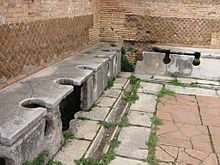
In the city of Rome, most people lived in multistory apartment buildings (insulae) that were often squalid firetraps. Public facilities—such as baths (thermae), toilets with running water (latrinae), basins or elaborate fountains (nymphea) delivering fresh water,[284] and large-scale entertainments such as chariot races and gladiator combat—were aimed primarily at the common people.[288] Similar facilities were constructed in cities throughout the Empire, and some of the best-preserved Roman structures are in Spain, southern France, and northern Africa.[citation needed]
The public baths served hygienic, social and cultural functions.[289] Bathing was the focus of daily socializing.[290] Roman baths were distinguished by a series of rooms that offered communal bathing in three temperatures, with amenities that might include an exercise room, sauna, exfoliation spa, ball court, or outdoor swimming pool. Baths had hypocaust heating: the floors were suspended over hot-air channels.[291] Public baths were part of urban culture throughout the provinces, but in the late 4th century, individual tubs began to replace communal bathing. Christians were advised to go to the baths only for hygiene.[292]

Rich families from Rome usually had two or more houses: a townhouse (domus) and at least one luxury home (villa) outside the city. The domus was a privately owned single-family house, and might be furnished with a private bath (balneum),[291] but it was not a place to retreat from public life.[293] Although some neighbourhoods show a higher concentration of such houses, they were not segregated enclaves. The domus was meant to be visible and accessible. The atrium served as a reception hall in which the paterfamilias (head of household) met with clients every morning.[280] It was a centre of family religious rites, containing a shrine and images of family ancestors.[294] The houses were located on busy public roads, and ground-level spaces were often rented out as shops (tabernae).[295] In addition to a kitchen garden—windowboxes might substitute in the insulae—townhouses typically enclosed a peristyle garden.[296]
The villa by contrast was an escape from the city, and in literature represents a lifestyle that balances intellectual and artistic interests (otium) with an appreciation of nature and agriculture.[297] Ideally a villa commanded a view or vista, carefully framed by the architectural design.[298] It might be located on a working estate, or in a "resort town" on the seacoast.[citation needed]
Augustus' programme of urban renewal, and the growth of Rome's population to as many as one million, was accompanied by nostalgia for rural life. Poetry idealized the lives of farmers and shepherds. Interior decorating often featured painted gardens, fountains, landscapes, vegetative ornament,[298] and animals, rendered accurately enough to be identified by species.[299] On a more practical level, the central government took an active interest in supporting agriculture.[300] Producing food was the priority of land use.[301] Larger farms (latifundia) achieved an economy of scale that sustained urban life.[300] Small farmers benefited from the development of local markets in towns and trade centres. Agricultural techniques such as crop rotation and selective breeding were disseminated throughout the Empire, and new crops were introduced from one province to another.[302]

Maintaining an affordable food supply to the city of Rome had become a major political issue in the late Republic, when the state began to provide a grain dole (Cura Annonae) to citizens who registered for it[300] (about 200,000–250,000 adult males in Rome).[303] The dole cost at least 15% of state revenues,[300] but improved living conditions among the lower classes,[304] and subsidized the rich by allowing workers to spend more of their earnings on the wine and olive oil produced on estates.[300] The grain dole also had symbolic value: it affirmed the emperor's position as universal benefactor, and the right of citizens to share in "the fruits of conquest".[300] The annona, public facilities, and spectacular entertainments mitigated the otherwise dreary living conditions of lower-class Romans, and kept social unrest in check. The satirist Juvenal, however, saw "bread and circuses" (panem et circenses) as emblematic of the loss of republican political liberty:[305]
The public has long since cast off its cares: the people that once bestowed commands, consulships, legions and all else, now meddles no more and longs eagerly for just two things: bread and circuses.[306]
Health and disease
Epidemics were common in the ancient world, and occasional pandemics in the Empire killed millions. The Roman population was unhealthy. About 20 percent—a large percentage by ancient standards—lived in cities, Rome being the largest. The cities were a "demographic sink": the death rate exceeded the birth rate and constant immigration was necessary to maintain the population. Average lifespan is estimated at the mid-twenties, and perhaps more than half of children died before reaching adulthood. Dense urban populations and poor sanitation contributed to disease. Land and sea connections facilitated and sped the transfer of infectious diseases across the empire's territories. The rich were not immune; only two of emperor Marcus Aurelius's fourteen children are known to have reached adulthood.[307]
The importance of a good diet to health was recognized by medical writers such as Galen (2nd century). Views on nutrition were influenced by beliefs like humoral theory.[308] A good indicator of nutrition and disease burden is average height: the average Roman was shorter in stature than the population of pre-Roman Italian societies and medieval Europe.[309]
Food and dining
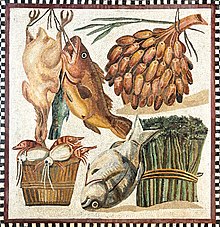
Most apartments in Rome lacked kitchens, though a charcoal brazier could be used for rudimentary cookery.[310] Prepared food was sold at pubs and bars, inns, and food stalls (tabernae, cauponae, popinae, thermopolia).[311] Carryout and restaurants were for the lower classes; fine dining appeared only at dinner parties in wealthy homes with a chef (archimagirus) and kitchen staff,[312] or banquets hosted by social clubs (collegia).[313]
Most Romans consumed at least 70% of their daily calories in the form of cereals and legumes.[314] Puls (pottage) was considered the food of the Romans,[315] and could be elaborated to produce dishes similar to polenta or risotto.[316] Urban populations and the military preferred bread.[314] By the reign of Aurelian, the state had begun to distribute the annona as a daily ration of bread baked in state factories, and added olive oil, wine, and pork to the dole.[317]
Roman literature focuses on the dining habits of the upper classes,[318] for whom the evening meal (cena) had important social functions.[319] Guests were entertained in a finely decorated dining room (triclinium) furnished with couches. By the late Republic, women dined, reclined, and drank wine along with men.[320] The poet Martial describes a dinner, beginning with the gustatio ("tasting" or "appetizer") salad. The main course was kid, beans, greens, a chicken, and leftover ham, followed by a dessert of fruit and wine.[321] Roman "foodies" indulged in wild game, fowl such as peacock and flamingo, large fish (mullet was especially prized), and shellfish. Luxury ingredients were imported from the far reaches of empire.[322] A book-length collection of Roman recipes is attributed to Apicius, a name for several figures in antiquity that became synonymous with "gourmet".[323]
Refined cuisine could be moralized as a sign of either civilized progress or decadent decline.[324] Most often, because of the importance of landowning in Roman culture, produce—cereals, legumes, vegetables, and fruit—were considered more civilized foods than meat. The Mediterranean staples of bread, wine, and oil were sacralized by Roman Christianity, while Germanic meat consumption became a mark of paganism.[325] Some philosophers and Christians resisted the demands of the body and the pleasures of food, and adopted fasting as an ideal.[326] Food became simpler in general as urban life in the West diminished and trade routes were disrupted;[327] the Church formally discouraged gluttony,[328] and hunting and pastoralism were seen as simple and virtuous.[327]
Spectacles
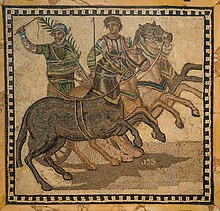
When Juvenal complained that the Roman people had exchanged their political liberty for "bread and circuses", he was referring to the state-provided grain dole and the circenses, events held in the entertainment venue called a circus. The largest such venue in Rome was the Circus Maximus, the setting of horse races, chariot races, the equestrian Troy Game, staged beast hunts (venationes), athletic contests, gladiator combat, and historical re-enactments. From earliest times, several religious festivals had featured games (ludi), primarily horse and chariot races (ludi circenses).[329] The races retained religious significance in connection with agriculture, initiation, and the cycle of birth and death.[r]
Under Augustus, public entertainments were presented on 77 days of the year; by the reign of Marcus Aurelius, this had expanded to 135.[331] Circus games were preceded by an elaborate parade (pompa circensis) that ended at the venue.[332] Competitive events were held also in smaller venues such as the amphitheatre, which became the characteristic Roman spectacle venue, and stadium. Greek-style athletics included footraces, boxing, wrestling, and the pancratium.[333] Aquatic displays, such as the mock sea battle (naumachia) and a form of "water ballet", were presented in engineered pools.[334] State-supported theatrical events (ludi scaenici) took place on temple steps or in grand stone theatres, or in the smaller enclosed theatre called an odeon.[335]
Circuses were the largest structure regularly built in the Roman world.[336] The Flavian Amphitheatre, better known as the Colosseum, became the regular arena for blood sports in Rome.[337] Many Roman amphitheatres, circuses and theatres built in cities outside Italy are visible as ruins today.[337] The local ruling elite were responsible for sponsoring spectacles and arena events, which both enhanced their status and drained their resources.[168] The physical arrangement of the amphitheatre represented the order of Roman society: the emperor in his opulent box; senators and equestrians in reserved advantageous seats; women seated at a remove from the action; slaves given the worst places, and everybody else in-between.[338] The crowd could call for an outcome by booing or cheering, but the emperor had the final say. Spectacles could quickly become sites of social and political protest, and emperors sometimes had to deploy force to put down crowd unrest, most notoriously at the Nika riots in 532.[339]

The chariot teams were known by the colours they wore. Fan loyalty was fierce and at times erupted into sports riots.[341] Racing was perilous, but charioteers were among the most celebrated and well-compensated athletes.[342] Circuses were designed to ensure that no team had an unfair advantage and to minimize collisions (naufragia),[343] which were nonetheless frequent and satisfying to the crowd.[344] The races retained a magical aura through their early association with chthonic rituals: circus images were considered protective or lucky, curse tablets have been found buried at the site of racetracks, and charioteers were often suspected of sorcery.[345] Chariot racing continued into the Byzantine period under imperial sponsorship, but the decline of cities in the 6th and 7th centuries led to its eventual demise.[336]
The Romans thought gladiator contests had originated with funeral games and sacrifices. Some of the earliest styles of gladiator fighting had ethnic designations such as "Thracian" or "Gallic".[346] The staged combats were considered munera, "services, offerings, benefactions", initially distinct from the festival games (ludi).[347] To mark the opening of the Colosseum, Titus presented 100 days of arena events, with 3,000 gladiators competing on a single day.[348] Roman fascination with gladiators is indicated by how widely they are depicted on mosaics, wall paintings, lamps, and in graffiti.[349] Gladiators were trained combatants who might be slaves, convicts, or free volunteers.[350] Death was not a necessary or even desirable outcome in matches between these highly skilled fighters, whose training was costly and time-consuming.[351] By contrast, noxii were convicts sentenced to the arena with little or no training, often unarmed, and with no expectation of survival; physical suffering and humiliation were considered appropriate retributive justice.[168] These executions were sometimes staged or ritualized as re-enactments of myths, and amphitheatres were equipped with elaborate stage machinery to create special effects.[168][352]
Modern scholars have found the pleasure Romans took in the "theatre of life and death"[353] difficult to understand.[354] Pliny the Younger rationalized gladiator spectacles as good for the people, "to inspire them to face honourable wounds and despise death, by exhibiting love of glory and desire for victory".[355] Some Romans such as Seneca were critical of the brutal spectacles, but found virtue in the courage and dignity of the defeated fighter[356]—an attitude that finds its fullest expression with the Christians martyred in the arena. Tertullian considered deaths in the arena to be nothing more than a dressed-up form of human sacrifice.[357] Even martyr literature, however, offers "detailed, indeed luxuriant, descriptions of bodily suffering",[358] and became a popular genre at times indistinguishable from fiction.[359]
Recreation
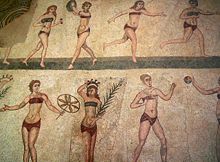
The singular ludus, "play, game, sport, training", had a wide range of meanings such as "word play", "theatrical performance", "board game", "primary school", and even "gladiator training school" (as in Ludus Magnus).[360] Activities for children and young people in the Empire included hoop rolling and knucklebones (astragali or "jacks"). Girls had dolls made of wood, terracotta, and especially bone and ivory.[361] Ball games include trigon and harpastum.[362] People of all ages played board games, including latrunculi ("Raiders") and XII scripta ("Twelve Marks").[363] A game referred to as alea (dice) or tabula (the board) may have been similar to backgammon.[364] Dicing as a form of gambling was disapproved of, but was a popular pastime during the festival of the Saturnalia.[citation needed]
After adolescence, most physical training for males was of a military nature. The Campus Martius originally was an exercise field where young men learned horsemanship and warfare. Hunting was also considered an appropriate pastime. According to Plutarch, conservative Romans disapproved of Greek-style athletics that promoted a fine body for its own sake, and condemned Nero's efforts to encourage Greek-style athletic games.[365] Some women trained as gymnasts and dancers, and a rare few as female gladiators. The "Bikini Girls" mosaic shows young women engaging in routines comparable to rhythmic gymnastics.[s][367] Women were encouraged to maintain health through activities such as playing ball, swimming, walking, or reading aloud (as a breathing exercise).[368]
Clothing

In a status-conscious society like that of the Romans, clothing and personal adornment indicated the etiquette of interacting with the wearer.[369] Wearing the correct clothing reflected a society in good order.[370] There is little direct evidence of how Romans dressed in daily life, since portraiture may show the subject in clothing with symbolic value, and surviving textiles are rare.[371][372]
The toga was the distinctive national garment of the male citizen, but it was heavy and impractical, worn mainly for conducting political or court business and religious rites.[373][371] It was a "vast expanse" of semi-circular white wool that could not be put on and draped correctly without assistance.[373] The drapery became more intricate and structured over time.[374] The toga praetexta, with a purple or purplish-red stripe representing inviolability, was worn by children who had not come of age, curule magistrates, and state priests. Only the emperor could wear an all-purple toga (toga picta).[375]
Ordinary clothing was dark or colourful. The basic garment for all Romans, regardless of gender or wealth, was the simple sleeved tunic, with length differing by wearer.[376] The tunics of poor people and labouring slaves were made from coarse wool in natural, dull shades; finer tunics were made of lightweight wool or linen. A man of the senatorial or equestrian order wore a tunic with two purple stripes (clavi) woven vertically: the wider the stripe, the higher the wearer's status.[376] Other garments could be layered over the tunic. Common male attire also included cloaks and in some regions trousers.[377] In the 2nd century, emperors and elite men are often portrayed wearing the pallium, an originally Greek mantle; women are also portrayed in the pallium. Tertullian considered the pallium an appropriate garment both for Christians, in contrast to the toga, and for educated people.[370][371][378]
Roman clothing styles changed over time.[379] In the Dominate, clothing worn by both soldiers and bureaucrats became highly decorated with geometrical patterns, stylized plant motifs, and in more elaborate examples, human or animal figures.[380] Courtiers of the later Empire wore elaborate silk robes. The militarization of Roman society, and the waning of urban life, affected fashion: heavy military-style belts were worn by bureaucrats as well as soldiers, and the toga was abandoned,[381] replaced by the pallium as a garment embodying social unity.[382]
Arts
Greek art had a profound influence on Roman art.[383] Public art—including sculpture, monuments such as victory columns or triumphal arches, and the iconography on coins—is often analysed for historical or ideological significance.[384] In the private sphere, artistic objects were made for religious dedications, funerary commemoration, domestic use, and commerce.[385] The wealthy advertised their appreciation of culture through artwork and decorative arts in their homes.[386] Despite the value placed on art, even famous artists were of low social status, partly as they worked with their hands.[387]
Portraiture
Portraiture, which survives mainly in sculpture, was the most copious form of imperial art. Portraits during the Augustan period utilize classical proportions, evolving later into a mixture of realism and idealism.[388] Republican portraits were characterized by verism, but as early as the 2nd century BC, Greek heroic nudity was adopted for conquering generals.[389] Imperial portrait sculptures may model a mature head atop a youthful nude or semi-nude body with perfect musculature.[390] Clothed in the toga or military regalia, the body communicates rank or role, not individual characteristics.[391] Women of the emperor's family were often depicted as goddesses or divine personifications.[citation needed]
Portraiture in painting is represented primarily by the Fayum mummy portraits, which evoke Egyptian and Roman traditions of commemorating the dead with realistic painting. Marble portrait sculpture were painted, but traces have rarely survived.[392]
Sculpture and sarcophagi
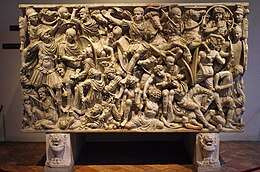
Examples of Roman sculpture survive abundantly, though often in damaged or fragmentary condition, including freestanding statuary in marble, bronze and terracotta, and reliefs from public buildings and monuments. Niches in amphitheatres were originally filled with statues,[393][394] as were formal gardens.[395] Temples housed cult images of deities, often by famed sculptors.[396]
Elaborately carved marble and limestone sarcophagi are characteristic of the 2nd to 4th centuries.[397] Sarcophagus relief has been called the "richest single source of Roman iconography",[398] depicting mythological scenes[399] or Jewish/Christian imagery[400] as well as the deceased's life.
Painting
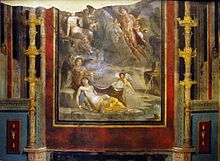
Initial Roman painting drew from Etruscan and Greek models and techniques. Examples of Roman paintings can be found in palaces, catacombs and villas. Much of what is known of Roman painting is from the interior decoration of private homes, particularly as preserved by the eruption of Vesuvius. In addition to decorative borders and panels with geometric or vegetative motifs, wall painting depicts scenes from mythology and theatre, landscapes and gardens, spectacles, everyday life, and erotic art.[citation needed]
Mosaic

Mosaics are among the most enduring of Roman decorative arts, and are found on floors and other architectural features. The most common is the tessellated mosaic, formed from uniform pieces (tesserae) of materials such as stone and glass.[402] Opus sectile is a related technique in which flat stone, usually coloured marble, is cut precisely into shapes from which geometric or figurative patterns are formed. This more difficult technique became especially popular for luxury surfaces in the 4th century (e.g. the Basilica of Junius Bassus).[403]
Figurative mosaics share many themes with painting, and in some cases use almost identical compositions. Geometric patterns and mythological scenes occur throughout the Empire. In North Africa, a particularly rich source of mosaics, homeowners often chose scenes of life on their estates, hunting, agriculture, and local wildlife.[401] Plentiful and major examples of Roman mosaics come also from present-day Turkey (particularly the (Antioch mosaics[404]), Italy, southern France, Spain, and Portugal.
Decorative arts
Decorative arts for luxury consumers included fine pottery, silver and bronze vessels and implements, and glassware. Pottery manufacturing was economically important, as were the glass and metalworking industries. Imports stimulated new regional centres of production. Southern Gaul became a leading producer of the finer red-gloss pottery (terra sigillata) that was a major trade good in 1st-century Europe.[405] Glassblowing was regarded by the Romans as originating in Syria in the 1st century BC, and by the 3rd century, Egypt and the Rhineland had become noted for fine glass.[406]
- Silver cup, from the Boscoreale Treasure (early 1st century AD)
- Finely decorated Gallo-Roman terra sigillata bowl
- Gold earrings with gemstones, 3rd century
- Glass cage cup from the Rhineland, 4th century
Performing arts

In Roman tradition, borrowed from the Greeks, literary theatre was performed by all-male troupes that used face masks with exaggerated facial expressions to portray emotion. Female roles were played by men in drag (travesti). Roman literary theatre tradition is particularly well represented in Latin literature by the tragedies of Seneca.[citation needed]
More popular than literary theatre was the genre-defying mimus theatre, which featured scripted scenarios with free improvisation, risqué language and sex scenes, action sequences, and political satire, along with dance, juggling, acrobatics, tightrope walking, striptease, and dancing bears.[407] Unlike literary theatre, mimus was played without masks, and encouraged stylistic realism. Female roles were performed by women.[408] Mimus was related to pantomimus, an early form of story ballet that contained no spoken dialogue but rather a sung libretto, often mythological, either tragic or comic.[409]

Although sometimes regarded as foreign, music and dance existed in Rome from earliest times.[410] Music was customary at funerals, and the tibia, a woodwind instrument, was played at sacrifices.[411] Song (carmen) was integral to almost every social occasion. Music was thought to reflect the orderliness of the cosmos.[412] Various woodwinds and "brass" instruments were played, as were stringed instruments such as the cithara, and percussion.[411] The cornu, a long tubular metal wind instrument, was used for military signals and on parade.[411] These instruments spread throughout the provinces and are widely depicted in Roman art.[413] The hydraulic pipe organ (hydraulis) was "one of the most significant technical and musical achievements of antiquity", and accompanied gladiator games and events in the amphitheatre.[411] Although certain dances were seen at times as non-Roman or unmanly, dancing was embedded in religious rituals of archaic Rome.[414] Ecstatic dancing was a feature of the mystery religions, particularly the cults of Cybele[415] and Isis. In the secular realm, dancing girls from Syria and Cadiz were extremely popular.[416]
Like gladiators, entertainers were legally infames, technically free but little better than slaves. "Stars", however, could enjoy considerable wealth and celebrity, and mingled socially and often sexually with the elite.[417] Performers supported each other by forming guilds, and several memorials for theatre members survive.[418] Theatre and dance were often condemned by Christian polemicists in the later Empire.[410][419]
Literacy, books, and education

Estimates of the average literacy rate range from 5 to over 30%.[420][421][422] The Roman obsession with documents and inscriptions indicates the value placed on the written word.[423][424][t] Laws and edicts were posted as well as read out. Illiterate Roman subjects could have a government scribe (scriba) read or write their official documents for them.[421][426] The military produced extensive written records.[427] The Babylonian Talmud declared "if all seas were ink, all reeds were pen, all skies parchment, and all men scribes, they would be unable to set down the full scope of the Roman government's concerns".[428]
Numeracy was necessary for commerce.[424][429] Slaves were numerate and literate in significant numbers; some were highly educated.[430] Graffiti and low-quality inscriptions with misspellings and solecisms indicate casual literacy among non-elites.[431][u][85]
The Romans had an extensive priestly archive, and inscriptions appear throughout the Empire in connection with votives dedicated by ordinary people, as well as "magic spells" (e.g. the Greek Magical Papyri).[432]
Books were expensive, since each copy had to be written out on a papyrus roll (volumen) by scribes.[433] The codex—pages bound to a spine—was still a novelty in the 1st century,[434] but by the end of the 3rd century was replacing the volumen.[435] Commercial book production was established by the late Republic,[436] and by the 1st century certain neighbourhoods of Rome and Western provincial cities were known for their bookshops.[437] The quality of editing varied wildly,[438] and plagiarism or forgery were common, since there was no copyright law.[436]

Collectors amassed personal libraries,[439] and a fine library was part of the cultivated leisure (otium) associated with the villa lifestyle.[440] Significant collections might attract "in-house" scholars,[441] and an individual benefactor might endow a community with a library (as Pliny the Younger did in Comum).[442] Imperial libraries were open to users on a limited basis, and represented a literary canon.[443] Books considered subversive might be publicly burned,[444] and Domitian crucified copyists for reproducing works deemed treasonous.[445]
Literary texts were often shared aloud at meals or with reading groups.[446] Public readings (recitationes) expanded from the 1st through the 3rd century, giving rise to "consumer literature" for entertainment.[447] Illustrated books, including erotica, were popular, but are poorly represented by extant fragments.[448]
Literacy began to decline during the Crisis of the Third Century.[449] The emperor Julian banned Christians from teaching the classical curriculum,[450] but the Church Fathers and other Christians adopted Latin and Greek literature, philosophy and science in biblical interpretation.[451] As the Western Roman Empire declined, reading became rarer even for those within the Church hierarchy,[452] although it continued in the Byzantine Empire.[453]
Education
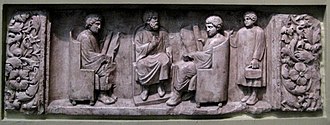
Traditional Roman education was moral and practical. Stories were meant to instil Roman values (mores maiorum). Parents were expected to act as role models, and working parents passed their skills to their children, who might also enter apprenticeships.[455] Young children were attended by a pedagogue, usually a Greek slave or former slave,[456] who kept the child safe, taught self-discipline and public behaviour, attended class and helped with tutoring.[457]
Formal education was available only to families who could pay for it; lack of state support contributed to low literacy.[458] Primary education in reading, writing, and arithmetic might take place at home if parents hired or bought a teacher.[459] Other children attended "public" schools organized by a schoolmaster (ludimagister) paid by parents.[460] Vernae (homeborn slave children) might share in-home or public schooling.[461] Boys and girls received primary education generally from ages 7 to 12, but classes were not segregated by grade or age.[462] Most schools employed corporal punishment.[463] For the socially ambitious, education in Greek as well as Latin was necessary.[464] Schools became more numerous during the Empire, increasing educational opportunities.[464]
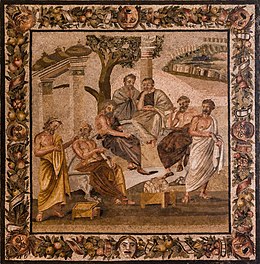
At the age of 14, upperclass males made their rite of passage into adulthood, and began to learn leadership roles through mentoring from a senior family member or family friend.[465] Higher education was provided by grammatici or rhetores.[466] The grammaticus or "grammarian" taught mainly Greek and Latin literature, with history, geography, philosophy or mathematics treated as explications of the text.[467] With the rise of Augustus, contemporary Latin authors such as Virgil and Livy also became part of the curriculum.[468] The rhetor was a teacher of oratory or public speaking. The art of speaking (ars dicendi) was highly prized, and eloquentia ("speaking ability, eloquence") was considered the "glue" of civilized society.[469] Rhetoric was not so much a body of knowledge (though it required a command of the literary canon[470]) as it was a mode of expression that distinguished those who held social power.[471] The ancient model of rhetorical training—"restraint, coolness under pressure, modesty, and good humour"[472]—endured into the 18th century as a Western educational ideal.[473]
In Latin, illiteratus could mean both "unable to read and write" and "lacking in cultural awareness or sophistication".[474] Higher education promoted career advancement.[475] Urban elites throughout the Empire shared a literary culture imbued with Greek educational ideals (paideia).[476] Hellenistic cities sponsored schools of higher learning to express cultural achievement.[477] Young Roman men often went abroad to study rhetoric and philosophy, mostly to Athens. The curriculum in the East was more likely to include music and physical training.[478] On the Hellenistic model, Vespasian endowed chairs of grammar, Latin and Greek rhetoric, and philosophy at Rome, and gave secondary teachers special exemptions from taxes and legal penalties.[479] In the Eastern Empire, Berytus (present-day Beirut) was unusual in offering a Latin education, and became famous for its school of Roman law.[480] The cultural movement known as the Second Sophistic (1st–3rd century AD) promoted the assimilation of Greek and Roman social, educational, and esthetic values.[481]
Literate women ranged from cultured aristocrats to girls trained to be calligraphers and scribes.[482][483] The ideal woman in Augustan love poetry was educated and well-versed in the arts.[484] Education seems to have been standard for daughters of the senatorial and equestrian orders.[461] An educated wife was an asset for the socially ambitious household.[482]
Literature
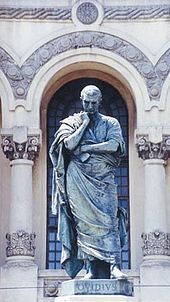
Literature under Augustus, along with that of the Republic, has been viewed as the "Golden Age" of Latin literature, embodying classical ideals.[485] The three most influential Classical Latin poets—Virgil, Horace, and Ovid—belong to this period. Virgil's Aeneid was a national epic in the manner of the Homeric epics of Greece. Horace perfected the use of Greek lyric metres in Latin verse. Ovid's erotic poetry was enormously popular, but ran afoul of Augustan morality, contributing to his exile. Ovid's Metamorphoses wove together Greco-Roman mythology; his versions of Greek myths became a primary source of later classical mythology, and his work was hugely influential on medieval literature.[486] Latin writers were immersed in Greek literary traditions, and adapted its forms and content, but Romans regarded satire as a genre in which they surpassed the Greeks. The early Principate produced the satirists Persius and Juvenal.[citation needed]
The mid-1st through mid-2nd century has conventionally been called the "Silver Age" of Latin literature. The three leading writers—Seneca, Lucan, and Petronius—committed suicide after incurring Nero's displeasure. Epigrammatist and social observer Martial and the epic poet Statius, whose poetry collection Silvae influenced Renaissance literature,[487] wrote during the reign of Domitian. Other authors of the Silver Age included Pliny the Elder, author of the encyclopedic Natural History; his nephew, Pliny the Younger; and the historian Tacitus.
The principal Latin prose author of the Augustan age is the historian Livy, whose account of Rome's founding became the most familiar version in modern-era literature. The Twelve Caesars by Suetonius is a primary source for imperial biography. Among Imperial historians who wrote in Greek are Dionysius of Halicarnassus, Josephus, and Cassius Dio. Other major Greek authors of the Empire include the biographer Plutarch, the geographer Strabo, and the rhetorician and satirist Lucian.[citation needed]
From the 2nd to the 4th centuries, Christian authors were in active dialogue with the classical tradition. Tertullian was one of the earliest prose authors with a distinctly Christian voice. After the conversion of Constantine, Latin literature is dominated by the Christian perspective.[488] In the late 4th century, Jerome produced the Latin translation of the Bible that became authoritative as the Vulgate. Augustine in The City of God against the Pagans builds a vision of an eternal, spiritual Rome, a new imperium sine fine that will outlast the collapsing Empire.[citation needed]
In contrast to the unity of Classical Latin, the literary esthetic of late antiquity has a tessellated quality.[489] A continuing interest in the religious traditions of Rome prior to Christian dominion is found into the 5th century, with the Saturnalia of Macrobius and The Marriage of Philology and Mercury of Martianus Capella. Prominent Latin poets of late antiquity include Ausonius, Prudentius, Claudian, and Sidonius Apollinaris.[citation needed]
Religion
The Romans thought of themselves as highly religious, and attributed their success to their collective piety (pietas) and good relations with the gods (pax deorum). The archaic religion believed to have come from the earliest kings of Rome was the foundation of the mos maiorum, "the way of the ancestors", central to Roman identity.[490] The priesthoods of the state religion were filled from the same pool of men who held public office, and the Pontifex Maximus was the emperor.[citation needed]
Roman religion was practical and contractual, based on the principle of do ut des, "I give that you might give". Religion depended on knowledge and the correct practice of prayer, ritual, and sacrifice, not on faith or dogma, although Latin literature preserves learned speculation on the nature of the divine. For ordinary Romans, religion was a part of daily life.[491] Each home had a household shrine to offer prayers and libations to the family's domestic deities. Neighbourhood shrines and sacred places such as springs and groves dotted the city. The Roman calendar was structured around religious observances; as many as 135 days were devoted to religious festivals and games (ludi).[492]
In the wake of the Republic's collapse, state religion adapted to support the new regime. Augustus justified one-man rule with a vast programme of religious revivalism and reform. Public vows now were directed at the wellbeing of the emperor. So-called "emperor worship" expanded on a grand scale the traditional veneration of the ancestral dead and of the Genius, the divine tutelary of every individual. Upon death, an emperor could be made a state divinity (divus) by vote of the Senate. The Roman imperial cult, influenced by Hellenistic ruler cult, became one of the major ways Rome advertised its presence in the provinces and cultivated shared cultural identity. Cultural precedent in the Eastern provinces facilitated a rapid dissemination of Imperial cult, extending as far as Najran, in present-day Saudi Arabia.[v] Rejection of the state religion became tantamount to treason. This was the context for Rome's conflict with Christianity, which Romans variously regarded as a form of atheism and superstitio.[citation needed]
The Romans are known for the great number of deities they honoured. As the Romans extended their territories, their general policy was to promote stability among diverse peoples by absorbing local deities and cults rather than eradicating them,[w] building temples that framed local theology within Roman religion. Inscriptions throughout the Empire record the side-by-side worship of local and Roman deities, including dedications made by Romans to local gods.[494] By the height of the Empire, numerous syncretic or reinterpreted gods were cultivated, among them cults of Cybele, Isis, Epona, and of solar gods such as Mithras and Sol Invictus, found as far north as Roman Britain. Because Romans had never been obligated to cultivate one god or cult only, religious tolerance was not an issue.[495]
Mystery religions, which offered initiates salvation in the afterlife, were a matter of personal choice, practiced in addition to one's family rites and public religion. The mysteries, however, involved exclusive oaths and secrecy, which conservative Romans viewed with suspicion as characteristic of "magic", conspiracy (coniuratio), and subversive activity. Thus, sporadic and sometimes brutal attempts were made to suppress religionists. In Gaul, the power of the druids was checked, first by forbidding Roman citizens to belong to the order, and then by banning druidism altogether. However, Celtic traditions were reinterpreted within the context of Imperial theology, and a new Gallo-Roman religion coalesced; its capital at the Sanctuary of the Three Gauls established precedent for Western cult as a form of Roman-provincial identity.[496] The monotheistic rigour of Judaism posed difficulties for Roman policy that led at times to compromise and granting of special exemptions. Tertullian noted that Judaism, unlike Christianity, was considered a religio licita, "legitimate religion". The Jewish–Roman wars resulted from political as well as religious conflicts; the siege of Jerusalem in 70 AD led to the sacking of the temple and the dispersal of Jewish political power (see Jewish diaspora).
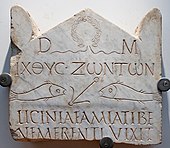
Christianity emerged in Roman Judaea as a Jewish religious sect in the 1st century and gradually spread out of Jerusalem throughout the Empire and beyond. Imperially authorized persecutions were limited and sporadic, with martyrdoms occurring most often under the authority of local officials.[497] Tacitus reports that after the Great Fire of Rome in AD 64, the emperor attempted to deflect blame from himself onto the Christians.[498] A major persecution occurred under the emperor Domitian[499] and a persecution in 177 took place at Lugdunum, the Gallo-Roman religious capital. A letter from Pliny the Younger, governor of Bithynia, describes his persecution and executions of Christians.[500] The Decian persecution of 246–251 seriously threatened the Christian Church, but ultimately strengthened Christian defiance.[501] Diocletian undertook the most severe persecution of Christians, from 303 to 311.[citation needed]
From the 2nd century onward, the Church Fathers condemned the diverse religions practiced throughout the Empire as "pagan".[502] In the early 4th century, Constantine I became the first emperor to convert to Christianity. He supported the Church financially and made laws that favored it, but the new religion was already successful, having moved from less than 50,000 to over a million adherents between 150 and 250.[503] Constantine and his successors banned public sacrifice while tolerating other traditional practices. Constantine never engaged in a purge,[504] there were no "pagan martyrs" during his reign,[505] and people who had not converted to Christianity remained in important positions at court.[504]: 302 Julian attempted to revive traditional public sacrifice and Hellenistic religion, but met Christian resistance and lack of popular support.[506]

Christians of the 4th century believed the conversion of Constantine showed that Christianity had triumphed over paganism (in Heaven) and little further action besides such rhetoric was necessary.[508] Thus, their focus was heresy.[509][510] According to Peter Brown, "In most areas, polytheists were not molested, and apart from a few ugly incidents of local violence, Jewish communities also enjoyed a century of stable, even privileged, existence".[510]: 641–643 [511] There were anti-pagan laws, but they were not generally enforced; through the 6th century, centers of paganism existed in Athens, Gaza, Alexandria, and elsewhere.[512]
According to recent Jewish scholarship, toleration of the Jews was maintained under Christian emperors.[513] This did not extend to heretics:[513] Theodosius I made multiple laws and acted against alternate forms of Christianity,[514] and heretics were persecuted and killed by both the government and the church throughout Late Antiquity. Non-Christians were not persecuted until the 6th century. Rome's original religious hierarchy and ritual influenced Christian forms,[515][516] and many pre-Christian practices survived in Christian festivals and local traditions.
Legacy
Several states claimed to be the Roman Empire's successor. The Holy Roman Empire was established in 800 when Pope Leo III crowned Charlemagne as Roman emperor. The Russian Tsardom, as inheritor of the Byzantine Empire's Orthodox Christian tradition, counted itself the Third Rome (Constantinople having been the second), in accordance with the concept of translatio imperii.[517] The last Eastern Roman titular, Andreas Palaiologos, sold the title of Emperor of Constantinople to Charles VIII of France; upon Charles' death, Palaiologos reclaimed the title and on his death granted it to Ferdinand and Isabella and their successors, who never used it. When the Ottomans, who based their state on the Byzantine model, took Constantinople in 1453, Mehmed II established his capital there and claimed to sit on the throne of the Roman Empire.[518] He even launched an invasion of Otranto with the purpose of re-uniting the Empire, which was aborted by his death. In the medieval West, "Roman" came to mean the church and the Catholic Pope. The Greek form Romaioi remained attached to the Greek-speaking Christian population of the Byzantine Empire and is still used by Greeks.[519]
Контроль Римской империи над итальянским полуостровом повлиял на итальянский национализм и объединение Италии ( Рисорджименто ) в 1861 году. [520] Roman imperialism was claimed by fascist ideology, particularly by the Italian Empire and Nazi Germany.[ нужна ссылка ]
В США основатели получили образование в классической традиции , [521] и использовал классические модели для достопримечательностей Вашингтона, округ Колумбия . [522] [523] [524] [525] Основатели рассматривали афинскую демократию и римский республиканизм как модели смешанной конституции , но считали императора фигурой тирании. [526]
См. также
- Очертание Древнего Рима
- Список политических систем во Франции
- Список римских династий
- Дацинь («Великий Цинь »), древнее китайское название Римской империи; см. также китайско-римские отношения
- Императорская Италия
- Византийская империя при династии Юстиниана
Примечания
- ^ Перейти обратно: а б Другие способы обозначения «Римской империи» у римлян включали Res publica Romana , Imperium Romanorum , Βασιλεία τῶν Ῥωμαίων ( Basileía tôn Rhōmaíōn – [«Доминион («королевство», но интерпретируемое как «империя») римлян»]) и Румыния . Res publica означает римское «содружество» и может относиться как к республиканской, так и к имперской эпохе. Imperium Romanum (или « Romanorum ») относится к территориальной протяженности римской власти. Populus Romanus («римский народ») часто использовался/используется для обозначения римского государства в вопросах, касающихся других наций. Термин Румыния , первоначально разговорный термин для обозначения территории империи, а также собирательное название ее жителей, появляется в греческих и латинских источниках, начиная с 4-го века, и в конечном итоге был перенесен в Восточную Римскую империю. [18]
- ^ Рис. 1. Регионы к востоку от реки Евфрат были удержаны только в 116–117 годах.
- ↑ В 286 году император Диоклетиан разделил Римскую империю на две административные единицы — Восточную и Западную — такое расположение периодически повторялось до тех пор, пока две половины не были окончательно разделены в 395 году. [3] Хотя на практике половины были независимыми, римляне продолжали считать Римскую империю единым неделимым государством с двумя равноправными императорами до падения западной половины в 476/480 году. [3] Хотя императоры иногда управляли из других городов (особенно Медиолана и Равенны на западе и Никомидии на востоке), Рим оставался де-юре столицей всей Римской империи. В 330 году император Константин I сделал Константинополь второй и новой столицей империи («Второй Рим» или «Новый Рим»). [4] [5] [6] [7] [8] [9] Какое-то время, в основном в течение последних десятилетий четвертого века, Рим продолжал сохранять более высокий символический статус из-за своей большей древности как имперская столица. [10] По крайней мере, с 361 года сенаторы, принадлежавшие к новому сенату в Константинополе, пользовались тем же статусом и привилегиями, что и сенаторы римского сената , которому новый сенат во многом был идентичен. [11] К 450 году Константинополь был намного величественнее по размерам и украшениям, чем Рим, и, несомненно, превосходил его по статусу. [12]
- ↑ В 1204 году крестоносцы Четвертого крестового похода захватили Константинополь и основали Латинскую империю . Город оставался под властью иностранцев до 1261 года, когда он был захвачен Никейской империей (государством-преемником Византии и Рима). Никею обычно считают «законным» продолжением Римской империи во время «междуцарствия» 1204–1261 годов (по сравнению с ее соперниками в Трапезунде и Фессалониках ), поскольку ей удалось вернуть себе Константинополь. [13] Вопрос о том, существовало ли вообще междуцарствие, является спорным, учитывая, что крестоносцы представляли Латинскую империю той же империей, что и ее предшественница (а не новым государством). [14]
- ^ Сокращенно «HS». Цены и стоимость обычно выражаются в сестерциях.
- ^ Османы иногда называли свое государство «Империей Рума » ( османский турецкий язык : دولت علنإه روم , букв. «Возвышенное государство Рим»). В этом смысле можно утверждать, что «Римская» империя просуществовала до начала 20 века. [20]
- ↑ Пруденций (348–413), в частности, христианизирует эту тему в своих стихах. [47] Святой Августин , однако, проводил различие между светским и вечным «Римом» в «Граде Божием» . См. также Страхи, Дж. Руфус (1981), «Культ Юпитера и римско-имперская идеология», « Взлет и падение римского мира » , том. II, с. 136 , о том, как классическая римская идеология повлияла на христианскую имперскую доктрину, Банг, Питер Фибигер (2011), «Царь царей: универсальная гегемония, имперская власть и новая сравнительная история Рима», Римская империя в контексте: исторические и сравнительные перспективы , John Wiley & Sons и греческая концепция глобализма ( ойкумене ).
- ^ Его называют состоянием двуязычия, но это верно только для образованных людей, и поэтому Бруно Рошетт предполагает, что это более уместно в качестве диглоссии , но признает, что это все еще не объясняет это адекватно, поскольку греческий язык был «высоким» по сравнению с латынью «Сверхвысоким». [59] Латынь пережила период распространения со второго века до нашей эры, особенно в западных провинциях, но не так сильно в восточных провинциях. [60] На востоке греческий язык всегда был доминирующим языком, оставшимся под влиянием эллинистического периода , предшествовавшего Империи. [61] [62]
- ^ Civis . («гражданин») явно контрастирует с перегриной , иностранкой или неримлянкой [109] В форме законного брака, называемой конубиум, правовой статус отца определял статус ребенка, но конубиум требовал, чтобы оба супруга были свободными гражданами. Солдату, например, запрещалось жениться во время службы, но если он заключил долгосрочный союз с местной женщиной во время службы в провинции, он мог законно жениться на ней после увольнения, и все дети, которые у них были, будут считается потомком граждан - фактически предоставляя женщине гражданство задним числом. Запрет действовал со времен Августа, пока он не был отменен Септимием Севером в 197 году нашей эры. [110]
- ^ Остальные — древние Афины , а в современную эпоху Бразилия , Карибский бассейн и США.
- ↑ Этим сенатором был Тиберий Клавдий Гордиан. [151]
- ^ Отношение конного ордена к парадам и демонстрациям «общественной лошади» и римской кавалерии (таким как Lusus Troiae ) является сложным, но те, кто участвовал в последних, похоже, были, например, всадниками , которым было предоставлено право высокостатусные (и весьма ограниченные) места в театре Lex Roscia theatralis . Сенаторы не могли владеть «общественной лошадью». [153]
- ^ Древние Гадес в римской Испании (ныне Кадис ) и Патавиум на кельтском севере Италии (ныне Падуя ) были нетипично богатыми городами, и наличие 500 всадников в одном городе было необычным. [155]
- ^ Эта практика установилась в республике; см., например, дело о правах Контребиана на воду, рассмотренное Г. Валериусом Флакком в качестве губернатора Испании в 90–80-х годах до нашей эры.
- ↑ Это была vicesima libertatis , «двадцатая свобода». [212]
- ^ Коллегия центонариев - неуловимая тема для научных исследований, поскольку они также широко известны как городские пожарные. [268] [269] Историк Цзинь Юй Лю рассматривает их как «в первую очередь торговцев и/или производителей, занимающихся производством и распространением шерстяных тканей и одежды низкого или среднего качества, включая войлок и изделия из него». [269]
- ^ Юлий Цезарь впервые применил латинское слово oppidum к этому типу поселений и даже назвал Аварикум ( Бурж , Франция), центр битуригов , urbs , «город». Археология показывает, что оппида были центрами религии, торговли (включая импорт/экспорт) и промышленного производства, окруженными стенами в целях защиты, но они, возможно, не были заселены концентрированным населением круглый год. [285]
- ^ Такие, как Консуалии и Октябрьское жертвоприношение коня . [330]
- ^ Ученые разделились во взглядах на спортивные и танцевальные элементы этих упражнений: Ли, Х. (1984). «Легкая атлетика и девушки в бикини с площади Пьяцца Армерина». Стадион . 10 : 45–75. видит в них гимнастов, а Торелли думает, что они танцоры на играх. [366]
- ↑ Клиффорд Андо задал вопрос: «Какую пользу принесут «опубликованные указы» в мире низкой грамотности?». [425]
- ^ Политические лозунги и непристойности широко сохранились в виде граффити в Помпеях: Антонио Вароне, Эротика Помпеи: любовные надписи на стенах Помпеи («L'Erma» ди Бретшнайдер, 2002). Солдаты иногда писали на пулях агрессивные надписи: Пханг, «Военные документы, языки и грамотность», с. 300.
- ↑ Кесареум в Наджаране , возможно, позже был известен как «Кааба Наджрана». [493]
- ^ «Этот менталитет, - отмечает Джон Т. Кох, - лежит в основе гениальности культурной ассимиляции, которая сделала возможной Римскую империю»; запись «Interpretatio romana» в «Кельтская культура: историческая энциклопедия» (ABC-Clio, 2006), стр. 974.
Ссылки
Цитаты
- ^ Морли, Невилл (2010). Римская империя: корни империализма . Плутон Пресс. ISBN 978-0-7453-2870-6 . ; Даймонд, Джаред (2011). Свернуть: как общества решают потерпеть неудачу или добиться успеха (пересмотренная ред.). Пингвин. п. 13. ISBN 978-1-1015-0200-6 .
- ^ Беннетт (1997) .
- ^ Перейти обратно: а б Древний Рим: Полная визуальная история . Дорлинг Киндерсли Лимитед. 2023. с. 276. ИСБН 978-0-2416-3575-9 . Архивировано из оригинала 22 июня 2023 года . Проверено 26 апреля 2023 г.
- ^ Классен, Альбрехт (2010). «Меняющийся облик Европы». Справочник по средневековым исследованиям: Термины – Методы – Тенденции . Вальтер де Грюйтер. ISBN 978-3-1102-1558-8 . Архивировано из оригинала 10 марта 2024 года . Проверено 26 апреля 2023 г.
Константин Великий перенес столицу Римской империи из Рима в новый город Константинополь.
- ^ Прайс, Джонатан Дж.; Финкельберг, Маргалит; Шахар, Юваль (2022). Рим: империя многих народов . Издательство Кембриджского университета. п. 19. ISBN 978-1-0092-5622-3 . Архивировано из оригинала 22 июня 2023 года . Проверено 26 апреля 2023 г.
столица Империи была перенесена из Рима в Константинополь в четвертом веке.
- ^ Эрдкамп, Пол (2013). Кембриджский спутник Древнего Рима . Издательство Кембриджского университета. п. 202. ИСБН 978-0-5218-9629-0 .
Константин озвучил похоронный звон по Риму как жизненно важному политическому центру, посвятив свою новую имперскую столицу Константинополю.
- ^ Бьёрнли, М. Шейн (2013). Политика и традиции между Римом, Равенной и Константинополем: исследование Кассиодора и Вариев, 527–554 . Издательство Кембриджского университета. п. 41. ИСБН 978-1-1070-2840-1 . Архивировано из оригинала 22 июня 2023 года . Проверено 26 апреля 2023 г.
Будучи новой столицей, Константинополь представлял собой сцену для имперского престижа, который не зависел от связи с традициями сенаторского истеблишмента в Риме.
- ^ Коффлер, Гейл Х. (2004). Намеки Мелвилла на религию: полный указатель и глоссарий: всеобъемлющий указатель и глоссарий . АВС-КЛИО. п. 181. ИСБН 978-0-3130-7270-3 . Архивировано из оригинала 22 июня 2023 года . Проверено 26 апреля 2023 г.
Он стал Константинополем, столицей всей Римской империи.
- ^ Максвелл, Кэтлин (2016). «Искусство и дипломатия в Константинополе конца тринадцатого века: Париж 54 и Союз церквей». Между Константинополем и Римом: Иллюминированное византийское Евангелие (Париж, гр. 54) и Союз Церквей . Рутледж. ISBN 978-1-3519-5584-3 . Архивировано из оригинала 22 июня 2023 года . Проверено 26 апреля 2023 г.
Константин Великий, император, перенесший столицу Римской империи из Рима в Константинополь.
- ^ Григ, Люси; Келли, Гэвин (2012). Два Рима: Рим и Константинополь в поздней античности . Издательство Оксфордского университета. п. 237. ИСБН 978-0-1999-2118-8 . Архивировано из оригинала 10 марта 2024 года . Проверено 26 апреля 2023 г.
- ^ Левенштейн, К. (2012). Управление РИМОМ . Спрингер. п. 443. ИСБН 978-9-4010-2400-6 . Архивировано из оригинала 22 июня 2023 года . Проверено 26 апреля 2023 г.
- ^ Харрис, Джонатан (2009). Константинополь: столица Византии . А&С Черный. п. 31. ISBN 978-0-8264-3086-1 . Архивировано из оригинала 22 июня 2023 года . Проверено 26 апреля 2023 г.
- ^ Тредголд (1997) , с. 734.
- ^ Трихт, Филип Ван (2011). Латинское обновление Византии: Константинопольская империя (1204–1228) . Брилл. стр. 61–82. ISBN 978-9-0042-0323-5 . Архивировано из оригинала 6 апреля 2023 года . Проверено 26 апреля 2023 г.
- ^ Перейти обратно: а б с д Таагепера, Рейн (1979). «Размер и продолжительность империй: кривые роста-упадка, с 600 г. до н.э. по 600 г. н.э.». История социальных наук . 3 (3/4): 125. дои : 10.2307/1170959 . JSTOR 1170959 .
- ^ Перейти обратно: а б Турчин, Петр ; Адамс, Джонатан М.; Холл, Томас Д. (2006). «Ориентация исторических империй Восток-Запад» (PDF) . Журнал исследований мировых систем . 12 (2): 222. Архивировано из оригинала (PDF) 17 мая 2016 года . Проверено 5 февраля 2016 г.
- ^ Дюран, Джон Д. (1977). «Исторические оценки мирового населения: оценка» . Обзор народонаселения и развития . 3 (3): 253–296. дои : 10.2307/1971891 . JSTOR 1971891 . Архивировано из оригинала 16 октября 2019 года . Проверено 30 октября 2018 г.
- ^ Вольф, Роберт Ли (1948). «Румыния: Латинская Константинопольская империя». Зеркало . 23 (1): 1–34, особенно 2–3. дои : 10.2307/2853672 . JSTOR 2853672 . S2CID 162802725 .
- ^ «Императорский Рим против провинциального Рима: в чем разница?» . Коллекционер . 7 октября 2020 г. Проверено 16 мая 2024 г.
- ^ Рой, Кошик (2014). Военный переход в Азии раннего Нового времени, 1400–1750: кавалерия, орудия, правительство и корабли . Исследования Блумсбери по военной истории. Издательство Блумсбери. п. 37. ИСБН 978-1-7809-3800-4 .
После захвата Константинополя столица Византийской империи стала столицей Османской империи. Турки-османы называли свою империю Империей Рума (Рима).
- ^ Келли (2007) , стр. 4 и далее; Николет (1991) , стр. 1, 15; Бреннан, Т. Кори (2000). Претура в Римской республике . Издательство Оксфордского университета. п. 605. Пичин (2011) , стр. 39–40.
- ^ Перейти обратно: а б с Поттер (2009) , с. 179.
- ^ Николет (1991) , стр. 1, 15.
- ^ Перейти обратно: а б Хекстер, Оливье; Кайзер, Тед (16–19 апреля 2009 г.). "Предисловие". Границы в римском мире: материалы девятого семинара по международному сетевому влиянию империи . Брилл: viii.
- ^ Линтотт, Эндрю (1999). Конституция Римской республики . Издательство Оксфордского университета. п. 114. ; Эдер, В. (1993). «Августовский принципат как связующее звено». Между Республикой и Империей . Издательство Калифорнийского университета. п. 98. ИСБН 0-5200-8447-0 .
- ^ Ричардсон, Джон (2011). «Штрафы провинциальные». Границы в римском мире . Брилл. п. 10.
- ^ Ричардсон (2011) , стр. 1–2.
- ^ Сайм, Рональд (1939). Римская революция . Издательство Оксфордского университета. стр. 3–4.
- ^ Боутрайт, Мэри Т. (2000). Адриан и города Римской империи . Издательство Принстонского университета. п. 4.
- ^ Дион Кассий , Римская история , перевод Кэри, Э. (издание Классической библиотеки Леба, изд. 1927 г.), стр. 72.36.4
- ^ Гиббон, Эдвард (1776 г.), «Упадок и падение на Западе - Глава 4» , «История упадка и падения Римской империи » , заархивировано из оригинала 24 августа 2017 г. , получено 27 июня 2017 г.
- ^ Голдсуорси (2009) , с. 50.
- ^ Браун, Питер (1971). Мир поздней античности . Харкорт Брейс Йованович. п. 22. ISBN 978-0-1519-8885-3 .
- ^ Голдсуорси (2009) , стр. 405–415.
- ^ Поттер, Дэвид (2004). Римская империя в безвыходном положении . Рутледж. стр. 296–298. ISBN 978-0-4151-0057-1 .
- ^ Старр, Честер Г. (1974) [1965]. История древнего мира (2-е изд.). Издательство Оксфордского университета. стр. 670–678. ISBN 978-0-1950-1814-1 .
- ^ Бери, Джон Бэгналл (1923). История Поздней Римской империи . Дуврские книги. стр. 295–297. Архивировано из оригинала 13 июля 2021 года . Проверено 19 февраля 2021 г.
- ^ Бери (1923) , стр. 312–313.
- ^ Перейти обратно: а б Шолль, Кристиан (2017). Транскультурные подходы к концепции имперского правления в средние века . Питер Ланг АГ. ISBN 978-3-6530-5232-9 .
Одоакр, свергнувший последнего римского императора Ромула Августула в 476 году, не использовал ни императорских знаков отличия, ни пурпурного цвета, который использовался императором только в Византии.
- ^ Перейти обратно: а б Питер, Хизер . «Падение Рима» . Би-би-си. Архивировано из оригинала 28 марта 2020 года . Проверено 11 февраля 2020 г.
- ^ Гиббон, Эдвард (1776). «Готическое королевство Италия. – Часть II». (электронная книга) . В Видгере, Дэвид (ред.). История упадка и падения Римской империи . Харпер и братья. Архивировано из оригинала 30 августа 2017 года . Проверено 11 февраля 2020 г. - через Project Gutenberg.
Патриций Орест женился на дочери графа Ромула из Петовио в Норике: имя Августа, несмотря на ревность к власти, было известно в Аквилее как знакомая фамилия; и имена двух великих основателей города и монархии были таким образом странным образом объединены в последнем из их преемников: «Жизнь этого безобидного юноши была сохранена щедрым милосердием Одоакра; который выгнал его со всей семьей из императорского дворца.
- ^ Гиббон, Эдвард (1776). «Готическое королевство Италия. – Часть II». . Упадок и падение Римской империи . Архивировано из оригинала 30 августа 2017 года . Проверено 11 февраля 2020 г. - через Project Gutenberg.
Республика (они повторяют это имя, не краснея) могла бы смело довериться гражданским и военным добродетелям Одоакра; и они смиренно просят, чтобы император возложил на него титул патриция и управление Итальянской епархией. ... Его тщеславие было удовлетворено титулом единоличного императора и статуями, воздвигнутыми в его честь в нескольких кварталах Рима; ... Он вел дружескую, хотя и двусмысленную переписку с патрицием Одоакром; и он с благодарностью принял императорские прапорщики.
- ^ Озген, Коркут. «Мехмед II» . TheOttomans.org . Архивировано из оригинала 30 апреля 2015 года . Проверено 3 апреля 2007 г. ; Картрайт, Марк (23 января 2018 г.). «1453: Падение Константинополя» . Энциклопедия всемирной истории . Архивировано из оригинала 12 апреля 2021 года . Проверено 11 февраля 2020 г.
- ^ Келли (2007) , с. 3.
- ^ Николет (1991) , с. 29.
- ^ Николет (1991) , с. 29; Вергилий , с. 1,278; Мэттингли, Дэвид Дж. (2011). Империализм, власть и идентичность: опыт Римской империи . Издательство Принстонского университета. п. 15. ; Моретти, Дж. (1993), «Другой мир и «антиподы»: миф о неизвестных странах между античностью и эпохой Возрождения», в книге де Грюйтера, Уолтера (ред.), Классическая традиция и Америка: европейские образы Америки , с. 257 ; Саузерн, Пэт (2001). Римская империя от Севера до Константина . Рутледж. стр. 14–16. ISBN 978-0-4152-3943-1 .
- ^ Мастранжело, Марк (2008). Римское «Я» в поздней античности: Пруденций и поэтика души . Издательство Университета Джонса Хопкинса. стр. 73, 203.
- ^ Мосли, Стивен (2010). Окружающая среда во всемирной истории . Рутледж. п. 35 .
- ^ Николет (1991) , стр. 7, 8.
- ^ Николет (1991) , стр. 9, 16.
- ^ Николет (1991) , стр. 10, 11.
- ^ Перейти обратно: а б Саузерн (2001) , стр. 14–16.
- ^ Перейти обратно: а б Келли (2007) , с. 1.
- ^ Перейти обратно: а б Моррис и Шайдель (2009) , с. 184.
- ^ Голдсмит, Раймонд В. (2005). «Оценка размера и структуры национального продукта ранней Римской империи». Обзор доходов и богатства . 30 (3): 263–288. дои : 10.1111/j.1475-4991.1984.tb00552.x .
- ^ Шайдель, Уолтер (апрель 2006 г.). «Население и демография» (PDF) . Рабочие документы Принстона/Стэнфорда по классической литературе . п. 9. Архивировано (PDF) из оригинала 13 ноября 2018 г. . Проверено 25 июля 2009 г. ; Хэнсон, JW; Ортман, С.Г. (2017). «Систематический метод оценки населения греческих и римских поселений». Журнал римской археологии . 30 : 301–324. дои : 10.1017/S1047759400074134 . S2CID 165770409 .
- ^ Перейти обратно: а б Бордман (2000) , с. 721.
- ^ Вульф, Грег, изд. (2003). Кембриджская иллюстрированная история римского мира . Айви Пресс. п. 340. ; Оппер, Торстен (2008). Адриан: Империя и конфликт . Издательство Гарвардского университета. п. 64. ; Филдс, Ник (2003). Стена Адриана 122–410 гг. н.э., которая, конечно же, находилась в нижней части сада Адриана . Издательство Оспри. п. 35.
- ^ Рошетт (2018) , с. 123.
- ^ Рошетт (2012) , стр. 562–563.
- ^ Рошетт (2018) , с. 108.
- ^ Миллар, Фергюс (2006). Греческая Римская империя: власть и вера при Феодосии II (408–450) . Издательство Калифорнийского университета. п. 279. ИСБН 0-5209-4141-1 . ; Тредголд (1997) , стр. 5–7.
- ^ Рошетт (2018) , с. 117.
- ^ Уоллес-Хэдрил, Эндрю (2010). Культурная революция в Риме (Реп. с корр.). Кембридж: Кембриджский университет. Нажимать. п. 60. ИСБН 978-0-5217-2160-8 .
- ^ Рошетт (1997, 2010, 1996, 1998, 2000, 2007), Дж. Н. Адамс (2003), Кирсли и Эванс (2001), Биндер (2000: 21–48), Ризакис (1995, 2008), Холфорд-Стривенс (1993) ), Петерсманн (1992), Дюбюиссон (1981, 1992a, 1992b), Миллар (2006a: 84–93), Маллен (2011), Гарсеа (2019), Фурне (2019), Рапп (2019), Нокки Маседо (). 2019), Пелиццари (2019), Роби (2019), Гиретти (1996), Гарсиа Доминго (1983), Згуста (1980), Каймио (1979a, 1979b), Хан (1906), Маллен и Джеймс (2012), Штейн ( 1915: 132–186), как цитируется в Дики, Элеонора (2023). Латинские заимствования в древнегреческом языке: лексикон и анализ (1-е изд.). Издательство Кембриджского университета. п. 4. дои : 10.1017/9781108888387 . ISBN 978-1-1088-8838-7 . S2CID 258920619 . Архивировано из оригинала 9 февраля 2024 года . Проверено 17 августа 2023 г.
- ^ Рошетт (2012) , с. 556; Адамс (2003) , с. 200.
- ^ Фини, Денис (2016). За пределами греческого: начало латинской литературы . Издательство Гарвардского университета. ISBN 978-0-6744-9604-0 . Архивировано из оригинала 4 октября 2023 года . Проверено 17 августа 2023 г.
- ^ Дики, Элеонора (2023). Латинские заимствования в древнегреческом языке: лексикон и анализ . Издательство Кембриджского университета. п. 651. ИСБН 978-1-1088-9734-1 . Архивировано из оригинала 4 октября 2023 года . Проверено 17 августа 2023 г.
- ^ Батстон, Уильям В. (2006). «Литература» . В Розенштейне, Натан; Морштейн-Маркс, Роберт (ред.). Товарищ Римской республики (1-е изд.). Уайли. стр. 543–564. дои : 10.1002/9780470996980.ch25 . ISBN 978-1-4051-0217-9 . Архивировано из оригинала 18 июля 2023 года . Проверено 17 августа 2023 г.
- ^ Фриман (2000) , с. 438.
- ^ CiceroЦицерон В Катилине Том. I 61 « Recto » ( изд. Райландса Папируса ). п. 2.15
- ^ Адамс 2003 , стр. 188, 197; Фримен 2000 , с. 394; Рошетт 2012 , с. 549
- ^ Блумер, В. Мартин (1997). Латинское и литературное общество в Риме . Издательство Пенсильванского университета. п. 4. ISBN 978-0-8122-3390-2 . Архивировано из оригинала 4 октября 2023 года . Проверено 17 августа 2023 г.
- ^ Рошетт (2018) , с. 122.
- ^ Ла Буа, Джузеппе (2019). Цицерон и римское образование: восприятие речей и древняя наука . Кембридж (Великобритания): Издательство Кембриджского университета. стр. 329 и далее. ISBN 978-1-1070-6858-2 .
- ^ Адамс (2003) , с. 205.
- ^ Рошетт 2023 , с. 263, 268; Рошетт 2018 , стр. 114–115, 118.
- ^ Рошетт (2018) .
- ^ Адамс (2003) , стр. 185–186, 205.
- ^ Перейти обратно: а б Тредголд (1997) , стр. 5–7.
- ^ Рошетт (2018) , стр. 108–109.
- ^ Карлтон, Чарльз Мерритт (1973). Лингвистический анализ собрания поздних латинских документов, составленного в Равенне между 445–700 гг. н.э. дои : 10.1515/9783111636221 . ISBN 978-3-1116-3622-1 . Архивировано из оригинала 10 марта 2024 года . Проверено 17 августа 2023 г.
"стр. 37. Согласно Pei & Gaeng (1976: 76–81), решающий момент наступил с исламским завоеванием Северной Африки и Иберии, за которым последовали многочисленные набеги на суше и на море. Все это имело эффект разрушения связи между западными романоязычными регионами.
- ^ Перейти обратно: а б с Майлз, Ричард (2000). «Общение культуры, идентичности и власти». Опыт власти: культура, идентичность и власть в Римской империи . Рутледж. стр. 58–60. ISBN 0-4152-1285-5 .
- ^ Рошетт (2012) , с. 550; Циммер, Стефан (2006). «Индоевропейский». Кельтская культура: Историческая энциклопедия . АВС-Клио. п. 961.
- ^ Перейти обратно: а б Курчин, Леонард А. (1995). «Грамотность в римских провинциях: качественные и количественные данные из Центральной Испании». Американский журнал филологии . 116 (3): 461–476 (464). дои : 10.2307/295333 . JSTOR 295333 .
- ^ Рошетт (2012) , стр. 558–559.
- ^ Адамс (2003) , с. 199.
- ^ Хист. Откровенный , книга 1, 32 И когда он пришел в Арверну, он поджег, разрушил и разрушил тот форт, который по-французски называют Вассо Галатае. И придя в Клермон [к арвернам ], он поджег, опрокинул и разрушил ту святыню, которую они на галльском языке называют Вассо Галаты,
- ^ Хеликс, Лоуренс (2011). История французского языка . Ellipses Edition Marketing SA с. 7. ISBN 978-2-7298-6470-5 .
Упадок галлов и их исчезновение нельзя объяснить только специфическими культурными практиками: когда римляне во главе с Цезарем вторглись в Галлию в I веке до нашей эры, она романизировалась прогрессивным и глубоким образом. В течение почти 500 лет знаменитого галло-римского периода сосуществовали галльский и разговорная латынь; снова в VI веке; свидетельства Григория Турского свидетельствуют о выживании галльского языка.
- ^ Гитер, Генри (1995). «На галльском субстрате в Румынии». Бочнакова, Анна; Уидлок, Станиленд (ред.). Дружба Мунуса. Studia лингвистика в честь семидесятилетнего Витольди Манчака . Краков. ; Рогист, Юджин (2006). К истокам романских языков: лингвистический маршрут по Румынии . Акко. п. 83. ; Савиньяк, Жан-Поль (2004). Французско-галльский словарь . Разница. п. 26. ; Матасович, Ранко (2007). «Островной кельтский язык как языковая область». Материалы стажировки в рамках XIII Международного конгресса кельтских исследований . Кельтские языки в контакте: 106 .; Адамс, Дж. Н. (2007). «V – Регионализмы в провинциальных текстах: Галлия». Региональная диверсификация латыни 200 г. до н. э. – 600 г. н. э . стр. 279–289 . дои : 10.1017/CBO9780511482977 . ISBN 978-0-5114-8297-7 .
- ^ Траск, Р.Л. (1997). История Басков . Рутледж. ISBN 0-4151-3116-2 . OCLC 34514667 .
- ^ Бард, Кэтрин А. (2005). Энциклопедия археологии Древнего Египта . Рутледж. стр. 252–254. ISBN 978-1-1346-6525-9 . ; Бард, Кэтрин А. (2015). Введение в археологию Древнего Египта . Джон Уайли и сыновья. п. 325. ИСБН 978-0-4706-7336-2 .
- ^ Пичин (2011) , с. 12.
- ^ Пичин (2011) , с. 16.
- ^ Пичин (2011) , с. 9.
- ^ Перейти обратно: а б с д и ж г Гарнси, Питер; Саллер, Ричард. Римская империя: экономика, общество и культура . Издательство Калифорнийского университета. стр. 107–111.
- ^ Норенья, Карлос Ф. (2011). Имперские идеалы на римском Западе: представительство, обращение, власть . Издательство Кембриджского университета. п. 7.
- ^ Пичин (2011) , стр. 4–5.
- ^ Винтерлинг (2009) , стр. 11, 21.
- ^ Саллер, Ричард П. (2002) [1982]. Личное покровительство в период Ранней Империи . Издательство Кембриджского университета. стр. 123, 176, 183. ; Дункан, Энн (2006). Производительность и идентичность в классическом мире . Издательство Кембриджского университета. п. 164.
- ^ Рейнхольд, Мейер (2002). Исследования классической истории и общества . Издательство Оксфордского университета. стр. 25 и далее, 42.
- ^ Бордман (2000) , с. 18.
- ^ Пичин (2011) , стр. 17, 20.
- ^ Миллар (2012) , стр. 81–82.
- ^ Кэрролл, Морин (2006). Духи мертвых: римские погребальные поминки в Западной Европе . Издательство Оксфордского университета. стр. 45–46.
- ^ Фриер и Макгинн (2004) , с. 14; Прибыль , институты 1.9 Дайджест 1.5.3.
- ^ Фриер и Макгинн (2004) , стр. 31–32.
- ^ Поттер (2009) , с. 177.
- ^ Шервин-Уайт, А.Н. (1979), Римское гражданство , Oxford University Press, стр. 211, 268 ; Фриер и Макгинн (2004) , стр. 31–32, 457.
- ^ Пханг, Сара Элиза (2001). Брак римских солдат (13 г. до н. э. – 235 г. н. э.): Закон и семья в императорской армии . Брилл. п. 2. ; Саузерн, Пэт (2006). Римская армия: социальная и институциональная история . Издательство Оксфордского университета. п. 144.
- ^ Роусон (1987) , с. 18.
- ^ Фриер и Макгинн (2004) , с. 461; Бордман (2000) , с. 733.
- ^ Вудхалл, Маргарет Л. (2004). «Матроны-покровители в ранней Римской империи: случай Сальвии Постумы». Влияние женщин на классическую цивилизацию . Рутледж. п. 77.
- ^ Фриер и Макгинн (2004) , стр. 19–20.
- ^ Кантарелла, Ева (1987). Дочери Пандоры: роль и статус женщин в греческой и римской древности . Издательство Университета Джонса Хопкинса. стр. 140–141. ; Салливан, JP (1979). «Сексуальные отношения Марсьяля». Филолог . 123 (1–2): 296. doi : 10.1524/phil.1979.123.12.288 . S2CID 163347317 .
- ^ Роусон (1987) , с. 15.
- ^ Фриер и Макгинн (2004) , стр. 19–20, 22.
- ^ Треджиари, Сьюзен (1991). Римский брак: «Iusti Coniuges» со времен Цицерона до времен Ульпиана . Издательство Оксфордского университета. стр. 100-1 258–259, 500–502. ISBN 0-1981-4939-5 .
- ^ Джонстон, Дэвид (1999). «3,3». Римское право в контексте . Издательство Кембриджского университета. ; Фриер и Макгинн (2004) , Ч. IV; Томас, Ян (1991). «Разделение полов в римском праве». История женщин от древних богинь до христианских святых . Издательство Гарвардского университета. п. 134.
- ^ Севери, Бет (2002). Август и семья при зарождении империи . Рутледж. п. 12. ISBN 1-1343-9183-8 .
- ^ Severy (2002) , p. 4.
- ^ Макгинн, Томас Эй Джей (1991). «Сожительство и закон Юлии о прелюбодеянии». Труды Американской филологической ассоциации . 121 : 335–375 (342). дои : 10.2307/284457 . JSTOR 284457 . ; Муссбаум, Марта К. (2002). «Неполный феминизм Мусония Руфа, платоника, стоика и римлянина». Сон разума: эротический опыт и сексуальная этика в Древней Греции и Риме . Издательство Чикагского университета. п. 305. , отмечая, что обычаи «предоставляют большую свободу для личных переговоров и постепенных социальных изменений»; Фантэм, Элейн (2011). « Изнасилование : общественное отношение и наказания за сексуальные преступления в республиканском Риме». Римские чтения: римский ответ на греческую литературу от Плавта до Статия и Квинтилиана . Вальтер де Грюйтер. п. 124. , цитируя Папиниана , De adulteriis I и Модестина , Book Regularum I. Кантарелла, Ева (2002) [1988 (итальянский), 1992]. Бисексуальность в Древнем мире . Издательство Йельского университета. п. 104. ; Эдвардс (2007) , стр. 34–35.
- ^ Грейс, Анджела (28 августа 2015 г.). «Fecunditas, Sterilitas и политика воспроизводства в Риме» . Йорк Спейс .
- ^ Перейти обратно: а б Брэдли (1994) , с. 12.
- ^ Брэдли (1994) , с. 15.
- ^ Харрис (1999) , стр. 62–75; Тейлор, Тимоти (2010). «Веря древним: Количественные и качественные измерения рабства и работорговли в поздней доисторической Евразии». Мировая археология . 33 (1): 27–43. arXiv : 0706.4406 . дои : 10.1080/00438240120047618 . S2CID 162250553 .
- ^ Харпер, Кайл (2011). Рабство в позднеримском мире, 275–425 гг . н.э. Издательство Кембриджского университета. стр. 10–16.
- ^ Фриер и Макгинн (2004) , стр. 7.
- ^ Макгинн, Томас Эй Джей (1998). Проституция, сексуальность и закон в Древнем Риме . Издательство Оксфордского университета. п. 314. ИСБН 0-1951-6132-7 . ; Гарднер, Джейн Ф. (1991). Женщины в римском праве и обществе . Издательство Университета Индианы. п. 119.
- ^ Фриер и Макгинн (2004) , стр. 31–33.
- ^ Фриер и Макгинн (2004) , стр. 21.
- ^ Гамауф, Ричард (2009). «Рабы, занимающиеся бизнесом: роль римского права в экономике римского дома». Европейский обзор истории . 16 (3): 331–346. дои : 10.1080/13507480902916837 . S2CID 145609520 .
- ^ Брэдли (1994) , стр. 2–3.
- ^ Брэдли (1994) , с. 10.
- ^ Фурманн, CJ (2012). Полиция Римской империи: солдаты, администрация и общественный порядок . Издательство Оксфордского университета. стр. 21–41. ISBN 978-0-1997-3784-0 .
- ^ Макгинн (1998) , стр. 288 и далее.
- ^ Абуш, Раанан (2003). «Обрезание и кастрация по римскому праву в ранней Империи». Завет обрезания: новые взгляды на древний еврейский обряд . Издательство Университета Брандейса. стр. 77–78. ; Шефер, Питер (2003) [1983]. История евреев в греко-римском мире . Рутледж. п. 150.
- ^ Фриер и Макгинн (2004) , стр. 15; Гудвин, Стефан (2009). Африка в Европе: античность в эпоху глобальной экспансии . Том. 1. Лексингтонские книги. п. 41. ИСБН 978-0-7391-1726-2 .
Римское рабство было нерасистской и подвижной системой.
- ^ Сантосуоссо, Антонио (2001). Штурм небес: солдаты, императоры и гражданские лица в Римской империи . Вествью Пресс. стр. 43–44. ISBN 0-8133-3523-Х .
- ^ Ной, Дэвид (2000). Иностранцы в Риме: граждане и иностранцы . Дакворт из классической прессы Уэльса. ISBN 978-0-7156-2952-9 .
- ^ Харпер, Джеймс (1972). «Рабы и вольноотпущенники в императорском Риме». Американский журнал филологии . 93 (2): 341–342. дои : 10.2307/293259 . JSTOR 293259 .
- ^ Харрис (1999) .
- ^ Роусон (1987) , стр. 186–188, 190; Брэдли (1994) , стр. 34, 48–50.
- ^ Миллар, Фергюс (2002) [1998]. Толпа в Риме в Позднюю республику . Мичиганский университет. стр. 23, 209. ISBN. 0-4720-8878-5 .
- ^ Муритсен, Хенрик (2011). Вольноотпущенник в римском мире . Издательство Кембриджского университета. п. 36.
- ^ Перейти обратно: а б Бергер, Адольф (1991) [1953]. «либертус». Энциклопедический словарь римского права . Американское филологическое общество. п. 564.
- ^ Бордман (2000) , стр. 217–218; Сайм, Рональд (1999). Провинциал в Риме: Рим и Балканы 80 г. до н.э. – 14 г. н.э. Эксетерский университет Press. стр. 12–13. ISBN 0-8598-9632-3 .
- ^ Бордман (2000) , стр. 215, 221–222; Миллар (2012) , с. 88. Стандартный состав в 600 человек был гибким; двадцать квесторов , например, занимали свои должности каждый год и, таким образом, были допущены в Сенат независимо от того, были ли «свободные» места.
- ^ Перейти обратно: а б Миллар (2012) , с. 88.
- ^ Бордман (2000) , стр. 218–219.
- ^ Бордман (2000) , с. 219.
- ^ Макмаллен, Рамзи (1966). «Провинциальные языки в Римской империи». Американский журнал филологии . 87 (1): 1–17. дои : 10.2307/292973 . JSTOR 292973 .
- ^ Wiseman (1970) , стр. 78–79.
- ^ Wiseman (1970) , стр. 71–72, 76.
- ^ Страбон 3.169, 5.213
- ^ Wiseman (1970) , стр. 75–76, 78.
- ^ Страх, Эндрю (2007). «Война и общество». Кембриджская история греческих и римских войн: Рим от поздней республики до поздней империи . Том. 2. Издательство Кембриджского университета. стр. 214–215. ISBN 978-0-5217-8274-6 . ; Беннетт (1997) , с. 5.
- ^ Моррис и Шайдель (2009) , с. 188; Миллар (2012) , стр. 87–88.
- ^ Миллар (2012) , с. 96.
- ^ Либешуец, Вольфганг (2001). «Конец древнего города». Город в поздней античности . Тейлор и Фрэнсис. стр. 26–27.
- ^ Миллар (2012) , с. 90, называет их «статусными наименованиями».
- ^ Миллар (2012) , с. 91.
- ^ Миллар (2012) , с. 90.
- ^ Перейти обратно: а б с Вербовен, Коенраад (2007). «Ассоциативный порядок: статус и этос среди римских бизнесменов в поздней республике и ранней Империи» . Атенеум . 95 : 870–872. hdl : 1854/LU-395187 . Архивировано из оригинала 3 ноября 2018 года . Проверено 13 января 2017 г. ; Пичин (2011) , стр. 153–154.
- ^ Пичин (2011) , стр. 153–154; Перкинс, Джудит (2009). Раннехристианские и судебные органы . Вальтер де Грюйтер. стр. 245–246. ; Пичин (2011) , с. 475.
- ^ Пичин (2011) , стр. 153–154.
- ^ Гоган, Джуди Э. (2010). Убийство не было преступлением: убийства и власть в Римской республике . Издательство Техасского университета. п. 91. ИСБН 978-0-2927-2567-6 . ; Келли, Гордон П. (2006). История изгнания в Римской республике . Издательство Кембриджского университета. п. 8. ISBN 0-5218-4860-1 .
- ^ Перейти обратно: а б с д Коулман, К.М. (2012). «Роковые шарады: римские казни, поставленные как мифологические постановления». Журнал римских исследований . 80 : 44–73. дои : 10.2307/300280 . JSTOR 300280 . S2CID 163071557 .
- ^ Пичин (2011) , стр. 153–154; Робинсон, ОФ (2007). Уголовная практика и уголовная политика в Древнем Риме . Рутледж. п. 108.
- ^ Bohec (2000) , с. 8.
- ^ Bohec (2000) , стр. 14–15.
- ^ Плутарх , Моралия Моралия 813c и 814c; Поттер (2009) , стр. 181–182; Латтвак, Эдвард (1979) [1976]. Великая стратегия Римской империи . Издательство Университета Джонса Хопкинса. п. 30. ISBN 0-8018-2158-4 .
- ^ Поттер (2009) , с. 184.
- ^ Поттер (2009) , с. 181.
- ^ Смит, Уильям (1875). Словарь греческих и римских древностей . Джон Мюррей. стр. 105–106. Архивировано из оригинала 13 июля 2021 года . Проверено 11 февраля 2020 г.
- ^ Эбботт (1901) , с. 354.
- ^ Эбботт (1901) , с. 345.
- ^ Эбботт (1901) , с. 341.
- ^ Миллар, Фергюс (2004). «Императоры за работой». Рим, греческий мир и Восток: правительство, общество и культура в Римской империи . Том. 2. Издательство Университета Северной Каролины. стр. 3–22, особенно 4, 20. ISBN. 0-8078-5520-0 .
- ^ Бордман (2000) , стр. 195 и далее.
- ^ Бордман (2000) , стр. 205–209.
- ^ Бордман (2000) , стр. 202–203, 205, 210.
- ^ Бордман (2000) , с. 211.
- ^ Бордман (2000) , с. 212.
- ^ Перейти обратно: а б Миллар (2012) , с. 76.
- ^ Бордман (2000) , с. 215.
- ^ Бордман (2000) , с. 721; Винтерлинг (2009) , с. 16.
- ^ Голдсуорси (2003) , с. 80.
- ^ Винтерлинг (2009) , с. 16.
- ^ Тиньор, Роберт; и др. (2011). Миры вместе, миры отдельно: История мира (3-е изд.). WW Нортон и компания. п. 262 . ISBN 978-0-3939-3492-2 .
- ^ Эдмондсон (1996) , стр. 111–112.
- ^ Bohec (2000) , с. 9.
- ^ Хекстер, Оливье Дж. (2007). «Борьба за Рим: Император как военачальник». Влияние римской армии (200 г. до н. э. – 476 г. н. э.) . Брилл. п. 96.
- ^ Рот, Дж. (1994). «Размер и организация Римского императорского легиона». История . 43 (3): 346–362.
- ^ Голдсуорси (2003) , с. 183.
- ^ Перейти обратно: а б Моррис и Шайдель (2009) , с. 196.
- ^ Пенроуз, Джейн (2005). «9: Римляне ». Рим и ее враги: империя, созданная и разрушенная войной . Блумсбери США. п. 183. ИСБН 978-1-8417-6932-5 .
Раздел 3: Ранняя Империя 27 г. до н.э. – 235 г. н.э.
- ^ Тацита Анналы IV.5
- ^ Голдсуорси (2003) , с. 51.
- ^ Коннолли, Питер (1986). «Реконструкция римского седла». Британия . 17 : 353–355. дои : 10.2307/526559 . JSTOR 526559 . S2CID 164155025 . ; Коннолли, Питер; Ван Дриэль-Мюррей, Кэрол (1991). «Седло римской кавалерии». Британия . 22 :33–50. дои : 10.2307/526629 . JSTOR 526629 . S2CID 161535316 .
- ^ Голдсуорси (2003) , с. 114.
- ^ Поттер (2009) , с. 183.
- ^ Поттер (2009) , стр. 177–179, Большинство сохранившихся правительственных отчетов происходят из римского Египта, где климат сохранил папирусы.
- ^ Поттер (2009) , с. 179, Исключение Египта из сенаторских провинций относится к возвышению Октавиана до того, как он стал Августом: Египет был оплотом его последнего противника, Марка Антония и его союзницы Клеопатры .
- ^ Перейти обратно: а б с Поттер (2009) , с. 180.
- ^ Поттер (2009) , стр. 179, 187.
- ^ Поттер (2009) , с. 180; Фурманн (2012) , стр. 197, 214, 224.
- ^ Перейти обратно: а б Поттер (2009) , стр. 184–185.
- ^ Бозман, Адда Б. (2010). Политика и культура в международной истории от Древнего Ближнего Востока до начала современной эпохи (2-е изд.). Издатели транзакций. стр. 208–220.
- ^ Дигесер, Элизабет ДеПальма (2000). Создание христианской империи: Лактанций и Рим . Издательство Корнельского университета. п. 53.
- ^ Моррис и Шайдель (2009) , с. 183.
- ^ Перейти обратно: а б с д и Поттер (2009) , с. 187.
- ^ Поттер (2009) , стр. 185–187.
- ^ Моррис и Шайдель (2009) , с. 184; Поттер (2009) , с. 185.
- ^ Поттер (2009) , с. 185.
- ^ Перейти обратно: а б Поттер (2009) , с. 188.
- ^ Поттер (2009) , с. 186.
- ^ Кассий Дион 55.31.4.
- ^ Тацит , Анналы 13.31.2.
- ^ Поттер (2009) , стр. 286, 295.
- ^ Поттер (2009) , с. 286.
- ^ Перейти обратно: а б с Поттер (2009) , с. 285.
- ^ Поттер (2009) , с. 292.
- ^ Поттер (2009) , стр. 285–286, 296 и далее.
- ^ Поттер (2009) , с. 296.
- ^ Шайдель, Уолтер ; Моррис, Ян ; Саллер, Ричард, ред. (2007). Кембриджская экономическая история греко-римского мира . Издательство Кембриджского университета. ISBN 978-0-5217-8053-7 .
- ^ Ло Кашио, Элио ; Маланима, Паоло (2009). «ВВП в досовременных аграрных экономиках (1–1820 гг. Н.э.). Пересмотр оценок» . Rivista di Storia Economica . 25 (3): 391–420 (391–401). Архивировано из оригинала 16 января 2017 года . Проверено 13 января 2017 г.
- ^ Мэддисон, Ангус (2007). Контуры мировой экономики, 1–2030 гг. нашей эры. Очерки макроэкономической истории . Издательство Оксфордского университета. стр. 47–51. ISBN 978-0-1992-2721-1 .
- ^ Дайсон, Стивен Л. (1992). Сообщество и общество в римской Италии . Издательство Университета Джонса Хопкинса. п. 177. ИСБН 0-8018-4175-5 . цитирование Пакер, Дж. Э. Жилье среднего и низшего класса в Помпеях и Геркулануме: предварительное исследование, «In Neue Forschung в Помпеджи» , стр. 133–142.
- ^ Шайдель, Уолтер ; Фризен, Стивен Дж. (2010). «Размер экономики и распределение доходов в Римской империи» (PDF) . Журнал римских исследований . 99 : 61–91. дои : 10.3815/007543509789745223 . S2CID 202968244 . Архивировано (PDF) из оригинала 13 ноября 2018 года . Проверено 12 января 2017 г.
- ^ Страхи, Дж. Руфус (1981). «Теология победы в Риме: подходы и проблемы». Взлет и падение римского мира . Том II.17.2. стр. 752, 824. , Страхи, Дж. Руфус (1981). «Культ добродетелей и римско-имперская идеология». Взлет и падение римского мира . Том II.17.2. п. 908.
- ^ Перейти обратно: а б Кесслер, Дэвид; Темин, Петр (2010). «Деньги и цены в ранней Римской империи». Денежные системы греков и римлян . Издательство Оксфордского университета.
- ^ Перейти обратно: а б с д Харл, Кеннет В. (19 июня 1996 г.). Чеканка монет в римской экономике, 300 г. до н. э. — 700 г. н. э . Джу Пресс. стр. 125–135. ISBN 978-0-8018-5291-6 .
- ^ Боуман, Гарнси и Кэмерон (2005) , с. 333.
- ^ Уэллс, Колин (1984). Римская империя . Издательство Гарвардского университета. п. 8.
- ^ Перейти обратно: а б с д и ж Харрис (2010) .
- ^ Шайдель, Уолтер (2009). «Денежная система Ханьской и Римской империй». В Шайделе, Уолтер (ред.). Рим и Китай. Сравнительные перспективы империй древнего мира . Издательство Оксфордского университета. стр. 137–207 (205). ISBN 978-0-1953-3690-0 .
- ^ Харрис (2010) ; Андрео, Жан (1999). Банковское дело и бизнес в римском мире . Издательство Кембриджского университета. п. 2.
- ^ Тацит , Анналы 6.17.3.
- ^ Дункан-Джонс (1994) , стр. 3–4.
- ^ Сильва-Санчес, Ноэми; Армада, Хосе-Лойс (7 марта 2023 г.). «Воздействие римской горнодобывающей промышленности и металлургии на окружающую среду и его корреляция с археологическими данными: европейская перспектива» . Экологическая археология : 11. doi : 10.1080/14614103.2023.2181295 . ISSN 1461-4103 .
- ^ Сильва-Санчес, Ноэми; Армада, Хосе-Лойс (7 марта 2023 г.). «Воздействие римской горнодобывающей промышленности и металлургии на окружающую среду и его корреляция с археологическими данными: европейская перспектива» . Экологическая археология : 15. doi : 10.1080/14614103.2023.2181295 . ISSN 1461-4103 .
- ^ Эдмондсон, Дж. К. (1989). «Горное дело в Поздней Римской империи и за ее пределами: непрерывность или разрушение?» . Журнал римских исследований . 79 : 84–102. дои : 10.2307/301182 . ISSN 0075-4358 . JSTOR 301182 . S2CID 161980467 .
- ^ https://livrepository.liverpool.ac.uk/3066254/3/Hirt%20Warwick%20Publ.%20III%20%28revised%29.pdf
- ^ Уилсон, Эндрю (2002). «Машины, власть и древняя экономика». Журнал римских исследований . 92 : 1–32. дои : 10.2307/3184857 . JSTOR 3184857 . S2CID 154629776 .
- ^ Крэддок, Пол Т. (2008). «Горное дело и металлургия». В Олесоне, Джон Питер (ред.). Оксфордский справочник по технике и технологиям в классическом мире . Издательство Оксфордского университета. п. 108. ИСБН 978-0-1951-8731-1 . ; Сим, Дэвид; Ридж, Изабель (2002). Железо для орлов. Железная промышленность Римской Британии . Темпус. п. 23. ISBN 0-7524-1900-5 . ; Хили, Джон Ф. (1978). Горное дело и металлургия в греческом и римском мире . Темза и Гудзон. п. 196. ИСБН 0-5004-0035-0 . Предполагается производительная мощность c. 1,5 кг на душу населения.
- ^ Хонг, С.; Канделоне, Ж.-П.; Паттерсон, CC; Бутрон, CF (1996). «История древнего загрязнения при выплавке меди в римские и средневековые времена, зафиксированная во льдах Гренландии». Наука . 272 (5259): 246. Бибкод : 1996Sci...272..246H . дои : 10.1126/science.272.5259.246 . S2CID 176767223 .
- ^ Хонг, С; Канделоне, Япония; Паттерсон, CC; Бутрон, CF (1994). «Лед Гренландии свидетельствует о загрязнении полушария свинцом греческой и римской цивилизациями два тысячелетия назад» (PDF) . Наука . 265 (5180): 1841–1843. Бибкод : 1994Sci...265.1841H . дои : 10.1126/science.265.5180.1841 . ПМИД 17797222 . S2CID 45080402 . Архивировано (PDF) из оригинала 29 апреля 2019 года . Проверено 12 января 2017 г.
- ^ Перейти обратно: а б Де Каллатай, Франсуа (2015). «Греко-римская экономика в сверхдолгосрочной перспективе: свинец, медь и кораблекрушения». Журнал римской археологии . 18 : 361–372. дои : 10.1017/S104775940000742X . S2CID 232346123 .
- ^ Сеттл, DM; Паттерсон, CC (1980). «Свинец в альбакоре: Руководство по загрязнению свинцом американцев». Наука . 207 (4436): 1167–1176. Бибкод : 1980Sci...207.1167S . дои : 10.1126/science.6986654 . ПМИД 6986654 .
- ^ Паттерсон, CC (1972). «Запасы серебра и потери в древние и средневековые времена». Обзор экономической истории . 25 (2): 205–235 (табл. 2, 6). дои : 10.1111/j.1468-0289.1972.tb02173.x .
- ^ Моррис и Шайдель (2009) , с. 197.
- ^ Грин, Кевин (1990). Археология римской экономики . Издательство Калифорнийского университета. п. 17. ISBN 978-0-5200-7401-9 .
- ^ Бордман (2000) , с. 714.
- ^ Ульрих, Роджер Брэдли (2007). Роман Деревообработка . Издательство Йельского университета. стр. 1–2. ISBN 978-0-3001-0341-0 .
- ^ Ван Тилбург, Корнелис (2007). Дорожное движение и пробки в Римской империи . Рутледж. п. 33.
- ^ Перейти обратно: а б с Стамбо (1988) , с. 253.
- ^ Рэй Лоуренс , «Наземный транспорт в римской Италии: затраты, практика и экономика», в книге «Торговля, торговцы и древний город » (Routledge, 1998), стр. 129.
- ^ Бордман (2000) , с. 713.
- ^ Бордман (2000) , с. 710.
- ^ Бордман (2000) , стр. 717–729.
- ^ Боуман, Гарнси и Кэмерон (2005) , с. 404; Бордман (2000) , с. 719.
- ^ Гагарин (2010) , с. 323.
- ^ Темин, Петр (2004). «Рынок труда ранней Римской империи». Журнал междисциплинарной истории . 34 (4): 513–538. дои : 10.1162/002219504773512525 . S2CID 33380115 .
- ^ Джонс (1960) , стр. 184–185.
- ^ Перейти обратно: а б Джонс (1960) , с. 192.
- ^ Джонс (1960) , стр. 190–191.
- ^ Воут (2009) , с. 212.
- ^ Перейти обратно: а б Лю, Цзиньюй (2009). Collegia Centonariorum: Гильдии торговцев текстилем на римском Западе . Брилл.
- ^ Макдональд, Уильям Л. (1982). Архитектура Римской империи . Издательство Йельского университета. инжир. 131Б. ; Лехтман, Х.Н.; Хоббс, Л.В. (1987). «Римский бетон и римская архитектурная революция». Керамика и цивилизация . 3 : 81–128.
- ^ «Аполлодор Дамаскин» . Британника . 13 февраля 2024 года. Архивировано из оригинала 21 мая 2008 года . Проверено 26 августа 2012 г. ; Сартон, Джордж (1936). «Единство и разнообразие средиземноморского мира». Осирис . 2 : 406–463 (430). дои : 10.1086/368462 . S2CID 143379839 . ; Калькани, Джулиана; Абдулкарим, Маамун (2003). Аполлодор Дамаскин и колонна Траяна: от традиции к проекту . Л'Эрма Бретшнайдер. п. 11. ISBN 978-8-8826-5233-3 . ; Ян, Хонг-Сен; Чеккарелли, Марко (2009). Международный симпозиум по истории машин и механизмов: материалы HMM 2008 . Спрингер . п. 86. ИСБН 978-1-4020-9484-2 .
- ^ Смит, Норман (1970). «Римские плотины Субиако». Технологии и культура . 11 (1): 58–68. дои : 10.2307/3102810 . JSTOR 3102810 . S2CID 111915102 . ; Смит, Норман (1971). История плотин . Питер Дэвис. п. 26. ISBN 978-0-4321-5090-0 . ; Шниттер, Никлаус (1978). «Римские плотины». Древний мир . 8 (2): 25–32 (28).
- ^ Чендлер, Фиона (2001). Асборнская интернет-энциклопедия римского мира . Издательство Асборн. п. 80.
- ^ Форман, Джоан (1975). Римляне . Макдональд Образовательный. п. 34.
- ^ Кроу, Дж. (2007). «Земля, стены и вода в позднеантичном Константинополе». В Лаване, Л.; Занини, Э.; Сарантис, А. (ред.). Технология в переходный период 300–650 гг. н.э. Брилл.
- ^ Грин, Кевин (1990). Археология римской экономики . Издательство Калифорнийского университета. п. 39. ИСБН 978-0-5200-7401-9 .
- ^ Джонс и Бёрд (2012) , стр. 59–74.
- ^ Ритти, Туллия; Греве, Клаус; Кессенер, Пол (2007). «Рельеф каменной лесопилки с водяным приводом на саркофаге в Иераполисе и его последствия». Журнал римской археологии . 20 : 138–163 (156, сн. 74). дои : 10.1017/S1047759400005341 . S2CID 161937987 .
- ^ Поттер (2009) , с. 192.
- ^ Перейти обратно: а б с Рехак, Пол (2006). Империум и Космос: Август и Северное Марсово поле . Университет Висконсина Пресс. стр. 4–8.
- ^ Стамбо (1988) , стр. 23 и далее, 244.
- ^ Раджа, Рубина (2012). Городское развитие и региональная идентичность в провинциях Восточной Римской империи 50 г. до н. э. – н. э. 250 г. . Музей Тускуланум Пресс. стр. 215–218. ; Спербер, Дэниел (1998). Город в римской Палестине . Издательство Оксфордского университета.
- ^ Стамбо (1988) , стр. 252, 253.
- ^ Перейти обратно: а б Лонгфелло, Бренда (2011). Римский империализм и гражданский покровительство: форма, смысл и идеология в монументальных фонтанных комплексах . Издательство Кембриджского университета. стр. 1–2. ISBN 978-0-5211-9493-8 .
- ^ Хардинг, Д.В. (2007). Археология кельтского искусства . Рутледж. стр. 211–212. ISBN 978-1-1342-6464-3 . ; Коллис, Джон (2000). « Селтик Оппида». Сравнительное исследование тридцати культур городов-государств . Датское общество наук. стр. 229–238. ; Кельтское вождество, Кельтское государство: эволюция сложных социальных систем . Издательство Кембриджского университета. 1999 [1995]. п. 61.
- ^ Поттер (2009) , с. 192; Вергилий , с. 6.852
- ^ Поттер (2009) , стр. 185–186.
- ^ Джонс (2003) .
- ^ Эванс, Гарри Б. (1994). Распределение воды в Древнем Риме . Издательство Мичиганского университета. стр. 9–10.
- ^ Пичин (2011) , с. 366.
- ^ Перейти обратно: а б Фэган, Гаррет Г. (2001). «Происхождение римской общественной бани: последние подходы и будущие направления» (PDF) . Американский журнал археологии . 105 (3): 403–426. дои : 10.2307/507363 . JSTOR 507363 . S2CID 31943417 . Архивировано из оригинала (PDF) 24 февраля 2021 года . Проверено 12 января 2017 г.
- ^ Уорд, Рой Боуэн (1992). «Женщины в римских банях». Гарвардское богословское обозрение . 85 (2): 125–147. дои : 10.1017/S0017816000028820 . S2CID 161983440 .
- ^ Кларк (1991) , стр. 1–2.
- ^ Кларк (1991) , стр. 11–12.
- ^ Кларк (1991) , с. 2.
- ^ Стамбо (1988) , стр. 144, 147; Кларк (1991) , стр. 12, 17, 22 и далее.
- ^ Газда, Элейн К. (1991). "Введение". Римское искусство в частной сфере: архитектура и декор дома, виллы и острова . Издательство Мичиганского университета. п. 9. ISBN 0-4721-0196-Х .
- ^ Перейти обратно: а б Кларк (1991) , с. 19.
- ^ Яшемски, Вильгельмина Фимстер; Мейер, Фредерик Г. (2002). Естественная история Помпеи . Издательство Кембриджского университета. ISBN 978-0-5218-0054-9 .
- ^ Перейти обратно: а б с д и ж Моррис и Шайдель (2009) , с. 191.
- ^ Бордман (2000) , с. 679.
- ^ Моррис и Шайдель (2009) , стр. 195–196.
- ^ Моррис и Шайдель (2009) , с. 191, считая, что излишки пшеницы только из провинции Египет могут удовлетворить и превысить потребности города Рима и провинциальных армий.
- ^ Уайзман, ТП (2012). «Перепись в первом веке до нашей эры». Журнал римских исследований . 59 (1/2): 59–75. дои : 10.2307/299848 . JSTOR 299848 . S2CID 163672978 .
- ^ Кин, Кэтрин (2006). Определение жанра в римской сатире . Издательство Оксфордского университета. п. 36. ; Кёне, Экхарт (2000). «Хлеб и зрелища: политика развлечений». Гладиаторы и цезари: сила зрелища в Древнем Риме . Издательство Калифорнийского университета. п. 8.
- ^ Ювенал. Сатира . стр. 10.77–81.
- ^ Харпер, Кайл (2017). Судьба Рима . Издательство Принстонского университета. стр. 10, 30–31, 67–91. ISBN 978-0-6911-6683-4 .
- ^ Грант, Марк (2000). Гален о еде и диете . Рутледж. стр. 7, 11.
- ^ Харпер (2017) , стр. 75–79; Кепке, Никола; Батен, Йорг (1 апреля 2005 г.). «Биологический уровень жизни в Европе за последние два тысячелетия». Европейский обзор экономической истории . 9 (1): 61–95. дои : 10.1017/S1361491604001388 . hdl : 10419/47594 .
- ^ Стамбо (1988) , стр. 144, 178; Хиндс, Кэтрин (2010). Повседневная жизнь в Римской империи . Маршалл Кавендиш. п. 90.
- ^ Холлеран (2012) , с. 136 и далее.
- ^ Гагарин (2010) , с. 299.
- ^ Фаас, Патрик (2005) [1994]. За римским столом: еда и пиршества в Древнем Риме . Издательство Чикагского университета. п. 29.
- ^ Перейти обратно: а б Бордман (2000) , с. 681.
- ^ Плиний Старший , Естественная история , с. 19.83–84 ; Гауэрс, Эмили (2003) [1993]. Нагруженный стол: изображение еды в римской литературе . Издательство Оксфордского университета. п. 17. ; Гагарин (2010) , с. 198.
- ^ Стамбо (1988) , с. 144.
- ^ Моррис и Шайдель (2009) , с. 191; Стамбо (1988) , с. 146; Холлеран (2012) , с. 134.
- ^ Поттер (2009) , с. 354.
- ^ Поттер (2009) , с. 356.
- ^ Роллер, Мэтью Б. (2006). Поза за обедом в Древнем Риме . Издательство Принстонского университета. стр. 96 и далее.
- ^ Алкок, Джоан П. (2006). Еда в древнем мире . Гринвуд Пресс. п. 184.
- ^ SuetoniusСветоний Жизнь Вителлия п. 13.2. ; Гауэрс (2003) , с. 20
- ^ Кауфман, Кэти К. «Воспоминание о прошлых трапезах: кулинария по книге Апиция». Еда и память: материалы Оксфордского симпозиума по еде и плите . стр. 125 и далее.
- ^ Гагарин (2010) , с. 201.
- ^ Фландрен, Жан Луи; Монтанари, Массимо (1999). Еда: кулинарная история от древности до наших дней . Издательство Колумбийского университета. стр. 165–167. ISBN 978-0-2311-1154-6 .
- ^ Поттер (2009) , стр. 365–366.
- ^ Перейти обратно: а б Фландрин и Монтанари (1999) , стр. 165–167.
- ^ Бауэрсок, Браун и Грабарь (1999) , с. 455.
- ^ Борода, Мэри ; Норт, JA; Прайс, SRF (1998). Религии Рима: История . Издательство Кембриджского университета. п. 66.
- ^ Хамфри (1986) , стр. 544, 558; Буше-Леклерк, Огюст (1886). Руководство по римским учреждениям . Топор. п. 549. ; «Очищение». Сокровищница древних культов и ритуалов . ЛИМЦ 2004. с. 83.
- ^ Дайсон (2010) , с. 240.
- ^ Верснель, HS (1971). Триумф: исследование происхождения, развития и значения римского триумфа . Брилл. стр. 96–97.
- ^ Поттер и Маттингли (1999) , с. 242.
- ^ Поттер и Маттингли (1999) , стр. 235–236.
- ^ Поттер и Маттингли (1999) , стр. 223–224.
- ^ Перейти обратно: а б Поттер и Мэттингли (1999) , с. 303.
- ^ Перейти обратно: а б Хамфри (1986) , стр. 1–3.
- ^ Эдмондсон (1996) , стр. 73–74, 106; Оге (2012) , с. 54; Макклелланд, Джон (2007). Тело и разум: спорт в Европе от Римской империи до эпохи Возрождения . Рутледж. п. 67.
- ^ Дайсон (2010) , стр. 238–239; Гагарин (2010) , с. 85; Хамфри (1986) , с. 461; Макклелланд (2007) , с. 61.
- ^ Видеманн, Томас (1995) [1992]. Императоры и гладиаторы . Рутледж. п. 15.
- ^ Гагарин (2010) , с. 85; Хамфри (1986) , стр. 459, 461, 512, 630–631; Дайсон (2010) , с. 237.
- ^ Дайсон (2010) , с. 238.
- ^ Хамфри (1986) , стр. 18–21; Гагарин (2010) , с. 84.
- ^ Оге (2012) , стр. 131–132; Поттер и Мэттингли (1999) , с. 237
- ^ Дайсон (2010) , стр. 238–239; Оге (2012) , с. 144; Дикки, Мэтью (2001). Магия и волшебники в греко-римском мире . Рутледж. стр. 282–287. ; Д'Амбра, Ева (2007). «Гонки со смертью: цирковые саркофаги и поминовение детей в римской Италии». Конструкции детства в Древней Греции и Италии . Американская школа классических исследований в Афинах. стр. 348–349. ; Рюпке (2007) , с. 289
- ^ Поттер (2009) , с. 354; Эдвардс (2007) , с. 59; Поттер и Мэттингли (1999) , с. 305
- ^ Эдвардс (2007) , с. 59; Поттер и Мэттингли (1999) , с. 305
- ^ Хамфри (1986) , стр. 1–3; Кассий Дион 66,25; Эдвардс (2007) , с. 55.
- ^ Эдвардс (2007) , с. 49.
- ^ Эдвардс (2007) , с. 50.
- ^ Эдвардс (2007) , с. 55; Поттер и Мэттингли (1999) , с. 307; Макклелланд (2007) , с. 66, цитируя также Маркуса Юнкельмана.
- ^ Светоний . Нерон . п. 12.2. ; Эдмондсон (1996) , с. 73.
- ^ Макдональд, Марианна; Уолтон, Дж. Майкл (2007). Введение в «Кембриджский компаньон греческого и римского театра» . Издательство Кембриджского университета. п. 8.
- ^ Кайл, Дональд Г. (1998). Зрелища смерти в Древнем Риме . Рутледж. п. 81. ; Эдвардс (2007) , с. 63.
- ^ Плиний. Панегирик . п. 33.1. ; Эдвардс (2007) , с. 52.
- ^ Эдвардс (2007) , стр. 66–67, 72.
- ^ TertullianТертуллиан Из зрелищ . п. 12 . Эдвардс (2007) , стр. 59–60; Поттер и Мэттингли (1999) , с. 224
- ^ Эдвардс (2007) , с. 212.
- ^ Бауэрсок, GW (1995). Мученичество и Рим . Издательство Кембриджского университета. стр. 25–26. ; Кавалло и Чартье (1999) , с. 79; Хубер-Ребених, Герлинде (1999). «Житийная фантастика как развлечение». Латинская художественная литература: латинский роман в контексте . Рутледж. стр. 158–178. ; Ллевелин, СР; Ноббс, AM (2002). «Самое раннее датированное упоминание воскресенья в папирусах». Новые документы, иллюстрирующие раннее христианство . Вм. Б. Эрдманс. п. 109. ; Хильдебрандт, Хенрик (2006). «Раннее христианство в Римской Паннонии - факт или вымысел?». Studia Patristica: доклады, представленные на четырнадцатой международной конференции по патристическим исследованиям, проходившей в Оксфорде в 2003 г. Питерс. стр. 59–64. ; Андо (2000) , с. 382.
- ^ Оксфордский латинский словарь (переиздание). Кларендон Пресс. 1985 [1982]. стр. 1048–1049. ; Хабинек (2005) , стр. 5, 143.
- ^ Роусон (2003) , с. 128.
- ^ Макдэниел, Уолтон Брукс (1906). «Некоторые отрывки об играх с мячом». Труды и труды Американской филологической ассоциации . 37 : 121–134. дои : 10.2307/282704 . JSTOR 282704 .
- ^ Остин, Р.Г. (1934). «Римские настольные игры. I». Греция и Рим . 4 (10): 24–34. дои : 10.1017/s0017383500002941 . S2CID 162861940 .
- ^ Остин, Р.Г. (2009). «Римские настольные игры. II». Греция и Рим . 4 (11): 76–82. дои : 10.1017/S0017383500003119 . S2CID 248520932 .
- ^ Эйбен, Эмиэль (1977). Беспокойная молодежь в Древнем Риме . Рутледж. стр. 79–82, 110.
- ^ Торелли, М. (1988). «Пьяцца Армерина: Заметки по иконологии». В Рицце, Г. (ред.). Римская вилла дель Казале на площади Пьяцца Армерина . Катания. п. 152.
- ^ Данбабин, Кэтрин (1999). Мозаики греческого и римского мира . Издательство Кембриджского университета. п. 133. ИСБН 0-5210-0230-3 .
- ^ Хэнсон, Энн Эллис (1991). «Реструктуризация женской физиологии в Риме». Медицинские школы в Риме . Университет Нант. стр. 260, 264. , особенно со ссылкой на «Гинекологию» Сорана .
- ^ Гагарин (2010) , с. 230.
- ^ Перейти обратно: а б Кун, Линда Л. (1997). Священные вымыслы: святые женщины и агиография в поздней античности . Издательство Пенсильванского университета. стр. 57–58.
- ^ Перейти обратно: а б с Бибер, Маргарет (1959). «Римляне в греческом Гиматии (Romani Palliati) – вклад в историю копирования». Труды Американского философского общества . 103 (3): 374–417.
- ^ Воут (2009) , стр. 204–220, особенно 206, 211; Метро, Ги PR (2008). «Прудери и шик в позднеантичной одежде». Римское платье и ткани римской культуры . Университет Торонто Пресс. п. 286.
- ^ Перейти обратно: а б Воут (2009) , с. 216.
- ^ Метро (2008) , стр. 282–283.
- ^ Клеланд, Лиза (2007). Греческое и римское платье от А до Я. Рутледж. п. 194.
- ^ Перейти обратно: а б Гагарин (2010) , с. 231.
- ^ Воут (2009) , с. 218.
- ^ Тертуллиан , Де Паллий 5.2
- ^ Гагарин (2010) , с. 232.
- ^ Д'Амато, Рафаэле (2005). Римская военная одежда (3): 400–640 гг . н.э. Скопа. стр. 7–9. ISBN 1-8417-6843-Х .
- ^ Уикхэм, Крис (2009). Наследство Рима . Пингвин. п. 106. ИСБН 978-0-6700-2098-0 .
- ^ Воут (2009) , с. 217.
- ^ Куссер (2008) , стр. 4–5, 8.
- ^ Куссер (2008) , с. 1; Поттер (2009) , стр. 75–76.
- ^ Газда (1991) , стр. 1–3.
- ^ Занкер, Пол (1998) [1995]. Помпеи: общественная и частная жизнь . Перевод Шнайдера, Дебора Лукас. Издательство Гарвардского университета. п. 189.
- ^ Гагарин (2010) , стр. 312–313.
- ^ Тойнби, JMC (декабрь 1971 г.). «Римское искусство». Классический обзор . 21 (3): 439–442. дои : 10.1017/S0009840X00221331 . S2CID 163488573 .
- ^ Занкер, Пол (1988). Сила изображений в эпоху Августа . Издательство Мичиганского университета. стр. 5 и след.
- ^ Гагарин (2010) , с. 451.
- ^ Фейфер, Джейн (2008). Римские портреты в контексте . Вальтер де Грюйтер. п. 10.
- ^ Гагарин (2010) , с. 453.
- ^ Куссер (2008) , с. 13.
- ^ Стронг, Дональд (1988) [1976]. Римское искусство (2-е изд.). Издательство Йельского университета. п. 11.
- ^ Гагарин (2010) , стр. 274–275.
- ^ Гагарин (2010) , с. 242.
- ^ Ньюби, Захра (2011). «Миф и смерть: римские мифологические саркофаги». Спутник греческой мифологии . Блэквелл. п. 301.
- ^ Элснер и Хаскинсон (2011) , с. 14.
- ^ Элснер и Хаскинсон (2011) , с. 12.
- ^ Элснер и Хаскинсон (2011) , с. 1, 9.
- ^ Перейти обратно: а б Гагарин (2010) , с. 463.
- ^ Гагарин (2010) , с. 459.
- ^ Данбабин (1999) , стр. 254 и далее.
- ^ «Антиохия и бани Аполавсиса – История раскопок» . Музей Дж. Пола Гетти . 30 марта 2016 г. Архивировано из оригинала 18 марта 2020 г. . Проверено 16 июня 2020 г.
- ^ Гагарин (2010) , с. 202.
- ^ Мясник, Кевин (2003). Римская Сирия и Ближний Восток . Публикации Гетти. стр. 201 и далее. ISBN 0-8923-6715-6 . ; Боуман, Гарнси и Кэмерон (2005) , с. 421
- ^ Фантэм, Р. Элейн (1989). «Мим: недостающее звено в истории римской литературы». Классический мир . 82 (3): 153–163. дои : 10.2307/4350348 . JSTOR 4350348 . ; Слейтер, Уильям Дж. (2002). «Проблемы пантомимы: Цицерон Ad fam . 7.1 и Martial 9.38». Феникс . 56 (3/4): 315–329. дои : 10.2307/1192603 . JSTOR 1192603 . ; Поттер и Мэттингли (1999) , с. 257
- ^ Конте, Джан Бьяджо (1994). Латинская литература: история . Издательство Университета Джонса Хопкинса. п. 128.
- ^ Франклин, Джеймс Л. (1987). «Пантомимисты в Помпеях: Акций Аникет и его труппа». Американский журнал филологии . 108 (1): 95–107. дои : 10.2307/294916 . JSTOR 294916 . ; Старкс, Джон Х. младший (2008). «Актрисы пантомимы в латинских надписях». Новые направления в древней пантомиме . Издательство Оксфордского университета. стр. 95, 14 и далее.
- ^ Перейти обратно: а б Наэребут (2009) , с. 146.
- ^ Перейти обратно: а б с д Гинзберг-Клар, Мария Э. (2010). «Археология музыкальных инструментов в Германии римского периода». Мировая археология . 12 (3): 313–320. дои : 10.1080/00438243.1981.9979806 .
- ^ Хабинек (2005) , стр. 90 и далее.
- ^ Соня Мучник. Музыканты и музыкальные инструменты в римских и ранневизантийских мозаиках Земли Израиля: источники, предшественники и значение . Тель-Авивский университет.
- ^ Наеребут (2009) , стр. 146 и далее.
- ^ Наэребут (2009) , стр. 154, 157.
- ^ Наэребут (2009) , стр. 156–157.
- ^ Ричлин, Эми (1993). «Не раньше гомосексуализма: материальность цинедуса и римского закона против любви между мужчинами». Журнал истории сексуальности . 3 (4): 539–540.
- ^ Чапо, Эрик; Слейтер, Уильям Дж. (1994). Контекст древней драмы . Издательство Мичиганского университета. п. 377.
- ^ Макмаллен, Рамзи (1984). Христианизация Римской империи: (100–400 гг. н.э.) . Издательство Йельского университета. стр. 74–75, 84.
- ^ Харрис (1989) , с. 5; Джонсон и Паркер (2009) , стр. 3–4.
- ^ Перейти обратно: а б Краус, Ти Джей (2000). «(И) грамотность в нелитературных папирусах из греко-римского Египта: дальнейшие аспекты образовательного идеала в древних литературных источниках и в наше время». Мнемозина . 53 (3): 322–342 (325–327). дои : 10.1163/156852500510633 .
- ^ Пичин (2011) , стр. 89, 97–98.
- ^ Маттерн, Сьюзен П. (1999). Рим и враг: имперская стратегия в принципате . Издательство Калифорнийского университета. п. 197.
- ^ Перейти обратно: а б Морган, Тереза (1998). Грамотное образование в эллинистическом и римском мирах . Издательство Кембриджского университета. стр. 1–2. ; Джонсон и Паркер (2009) , с. 46 и далее; Пичин (2011) , с. 97.
- ^ Андо (2000) , с. 101, см. также с. 87 о «навязчивой правительственной документации».
- ^ Андо (2000) , с. 101.
- ^ Пханг, Сара Элиза (2011). «Военные документы, языки и грамотность». Товарищ римской армии . Блэквелл. стр. 286–301.
- ^ Андо (2000) , стр. 86–87.
- ^ Маттерн (1999) , с. 197.
- ^ Гагарин (2010) , стр. 19–20.
- ^ Харрис (1989) , стр. 9, 48, 215, 248, 26, 248, 258–269; Джонсон и Паркер (2009) , стр. 47, 54, 290 и далее.
- ^ Борода, Мэри (1991). «Древняя грамотность и письменное слово в римской религии». Грамотность в римском мире . Издательство Мичиганского университета. стр. 59 и далее. ; Дикки, Мэтью (2001). Магия и волшебники в греко-римском мире . Рутледж. стр. 94–95, 181–182, 196. ; Поттер (2009) , с. 555; Харрис (1989) , стр. 29, 218–219.
- ^ Джонсон (2010) , стр. 17–18.
- ^ Джонсон (2010) , с. 17, со ссылкой на Марсьяля, Эпиграммы , 1.2, 14.184–92; Кавалло и Чартье (1999) , стр. 83–84.
- ^ Джонсон (2010) , стр. 17–18; Кавалло и Чартье (1999) , стр. 84–85.
- ^ Перейти обратно: а б Маршалл (1976) , с. 253.
- ^ Кавалло и Чартье (1999) , стр. 71; Маршалл (1976) , с. 253, со ссылкой на книжную торговлю в провинциях Плиний Младший, Epistulae 9.11.2; Боевые эпиграммы 7.88; Гораций, Кармина 2.20.13f. и Арс Поэтика 345; Овидий, Тристия 4.9.21 и 4.10.128; Плиний Старший, Естественная история 35.2.11; Сидоний, Эпистулы 9.7.1.
- ^ Маршалл (1976) , с. 253; Страбон 13.1.54, 50.13.419; Боевой. Эпиграммы п. 2.8. ; Люциан , Против необразованных 1
- ^ Маршалл (1976) , стр. 252–264.
- ^ Кавалло и Шартье (1999) , стр. 67–68.
- ^ Маршалл (1976) , стр. 257–260.
- ^ Плиний Старший . Эпистулы . п. 1.8.2. ; CIL 5,5262 шекелей (= 2927 ); Маршалл (1976) , с. 265.
- ^ Маршалл (1976) , стр. 261–262; Кавалло и Чартье (1999) , с. 70
- ^ Тацит, Агрикола 2.1 и Анналы 4.35 и 14.50; Плиний Младший , Послания 7.19.6; Светоний, Август 31, Тиберий 61,3 и Калигула 16.
- ^ Светоний . Домициан . п. 10. ; QuintilianКвинтилиан Ораторское обучение . п. 9.2.65. ; Маршалл (1976) , с. 263.
- ^ Джонсон и Паркер (2009) , стр. 114 и далее, 186 и далее; Поттер (2009) , с. 372.
- ^ Кавалло и Шартье (1999) , стр. 68–69, 78–79.
- ^ Кавалло и Шартье (1999) , стр. 81–82.
- ^ Харрис (1989) , с. 3.
- ^ Гагарин (2010) , с. 19.
- ^ Числа, Рональд (2009). Галилей попадает в тюрьму и другие мифы о науке и религии . Издательство Гарвардского университета. п. 18. ISBN 978-0-6740-3327-6 . Архивировано из оригинала 30 августа 2022 года . Проверено 30 августа 2022 г.
- ^ Кавалло и Шартье (1999) , с. 86.
- ^ Кавалло и Шартье (1999) , стр. 15–16.
- ^ Пичин (2011) , с. 95.
- ^ Пичин (2011) , стр. 84–85.
- ^ Лаес (2011) , стр. 113–116.
- ^ Пичин (2011) , стр. 90, 92.
- ^ Лаес (2011) , с. 108; Пичин (2011) , с. 89.
- ^ Пичин (2011) , стр. 87–89.
- ^ Лаес (2011) , с. 122.
- ^ Перейти обратно: а б Пичин (2011) , с. 90.
- ^ Лаес (2011) , стр. 107–108, 132.
- ^ Пичин (2011) , стр. 93–94.
- ^ Перейти обратно: а б Пичин (2011) , с. 89.
- ^ Пичин (2011) , стр. 88, 106.
- ^ Лаес (2011) , с. 109.
- ^ Лаес (2011) , с. 132.
- ^ Поттер (2009) , стр. 439, 442.
- ^ Пичин (2011) , стр. 102–103, 105.
- ^ Пичин (2011) , стр. 104–105.
- ^ Пичин (2011) , стр. 103, 106.
- ^ Пичин (2011) , с. 110.
- ^ Пичин (2011) , с. 107.
- ^ Харрис (1989) , с. 5.
- ^ Саллер, Р.П. (2012). «Продвижение и покровительство в конной карьере». Журнал римских исследований . 70 : 44–63. дои : 10.2307/299555 . JSTOR 299555 . S2CID 163530509 .
- ^ Поттер (2009) , с. 598.
- ^ Лаес (2011) , стр. 109–110.
- ^ Пичин (2011) , с. 88.
- ^ Лаес (2011) , с. 110; Гагарин (2010) , с. 19.
- ^ Гагарин (2010) , с. 18.
- ^ Широкомасштабные исследования Второй софистики XXI века включают в себя Голдхилл, Саймон (2001). Быть греком под властью Рима: культурная идентичность, вторая софистика и развитие империи . Издательство Кембриджского университета. ; Борг, Барбара Э., изд. (2004). Пайдея: Мир второй софистики . Де Грютер. ; Уитмарш, Тим (2005). Вторая Софистика . Издательство Оксфордского университета.
- ^ Перейти обратно: а б Хабинек, Томас Н. (1998). Политика латинской литературы: письменность, идентичность и империя в Древнем Риме . Издательство Принстонского университета. стр. 122–123.
- ^ Роусон (2003) , с. 80.
- ^ Джеймс, Шэрон Л. (2003). Образованные девушки и мужское убеждение: гендер и чтение в римской любовной элегии . Издательство Калифорнийского университета. стр. 21–25. ; Джонсон, WR (2012). «Проперций». Сопровождение к римской любовной элегии . Блэквелл. стр. 42–43. ; Джеймс, Шэрон Л. (2012). «Элегия и новая комедия». Сопровождение к римской любовной элегии . Блэквелл. п. 262.
- ^ Робертс (1989) , с. 3.
- ^ Эпоха Овидия ; МакНелис, Чарльз (2007). «Стратегии Овидия в ранней имперской литературе». Спутник Овидия . Блэквелл. п. 397.
- ^ ван Дам, Харм-Ян (2008). «Снова блуждание по лесу: от Полициано до Гроция». Поэзия Статиуса . Брилл. стр. 45 и далее.
- ^ Альбрехт (1997) , с. 1294.
- ^ Робертс (1989) , с. 70.
- ^ Эйланд, Мюррей (2023). Изображение римских систем верований: иконография монет в республике и Империи . Британские археологические отчеты (Оксфорд) Лимитед. п. 22. дои : 10.30861/9781407360713 . ISBN 978-1-4073-6071-3 .
- ^ Рюпке (2007) , с. 4.
- ^ Бансон, Мэтью (1995). Словарь Римской империи . Издательство Оксфордского университета. п. 246.
- ^ Джавад Али, Аль-Муфассал фи Тарих Аль-Араб Кабл Аль-Ислам (Джавад Али, Аль-Муфассал фи Тарих Аль-Араб Кабл Аль-Ислам ; «Комментарий к истории арабов до ислама»), Багдад, 1955–1983; Харланд, П. (2003). «Имперские культы в местной культурной жизни: ассоциации в римской Азии». (первоначально опубликовано в) Бюллетене древней истории . Том 17. С. 91–103.
- ^ Рюпке (2007) , с. 4; Исаак, Бенджамин Х. (2004). Изобретение расизма в классической античности . Издательство Принстонского университета. п. 449. ; Френд, WHC (1967). Мученичество и преследования в ранней церкви: исследование конфликта от Маккавеев до Доната . Даблдэй. п. 106. ; Хаскинсон, Джанет (2000). Знакомство с Римом: культура, идентичность и власть в Римской империи . Рутледж. п. 261. . См., например, алтарь, посвященный римским гражданином и изображающий жертвоприношение, совершаемое на римский манер германской богине Вагдаверкустис во II веке нашей эры.
- ^ Момильяно, Арнальдо (1986). «Недостатки монотеизма для универсального государства». Классическая филология . 81 (4): 285–297. дои : 10.1086/367003 . S2CID 161203730 .
- ^ Фишвик, Дункан (1991). Имперский культ на латинском Западе: исследования культа правителя западных провинций Римской империи . Том. 1. Брилл. стр. 97–149. ISBN 9-0040-7179-2 .
- ^ Боуман, Гарнси и Кэмерон (2005) , с. 616; Френд, WHC (2006). «Преследования: Бытие и наследие». Кембриджская история христианства: от происхождения до Константина . Том. 1. Издательство Кембриджского университета. п. 510. ИСБН 0-5218-1239-9 . ; Барнс, Т.Д. (2012). «Законодательство против христиан». Журнал римских исследований . 58 (1–2): 32–50. дои : 10.2307/299693 . JSTOR 299693 . S2CID 161858491 . ; Сент-Круа, GEM de (1963). «Почему преследовались ранние христиане?». Прошлое и настоящее (26): 6–38. дои : 10.1093/прошлое/26.1.6 . ; Мусурильо, Герберт (1972). Деяния христианских мучеников Кларендон Пресс. стр. 100-1 lviii–lxii. ; Шервин-Уайт, А.Н. (1952). «Ранние гонения и снова римское право». Журнал богословских исследований . 3 (2): 199–213. дои : 10.1093/jts/III.2.199 .
- ^ Тацит. Анналы . п. .
- ^ Евсевий Кесарийский (425 г.). История Церкви . ; Смоллвуд, Э.М. (1956). « Отношение Домициана к евреям и иудаизму». Классическая филология . 51 : 1–13. дои : 10.1086/363978 . S2CID 161356789 .
- ^ Плиний. «Послание к Траяну о христианах» . Архивировано из оригинала 11 августа 2011 года.
- ^ Френд, WHC (1959). «Провал гонений в Римской империи». Прошлое и настоящее (16): 10–30. дои : 10.1093/прошлое/16.1.10 .
- ^ Бауэрсок, Браун и Грабарь (1999) , с. 625.
- ^ Харнетт, Бенджамин (2017). «Распространение Кодекса». Классическая античность . 36 (2): 200, 217. doi : 10.1525/ca.2017.36.2.183 .
- ^ Перейти обратно: а б Лейтхарт, Питер Дж. (2010). Защищая Константина. Сумерки империи и рассвет христианского мира . Межвузовская пресса. п. 304. ИСБН 978-0-8308-2722-0 .
- ^ Браун, Питер (2003). Возвышение западного христианского мира: триумф и разнообразие, 200–1000 гг. Н.э. (2-е изд.). Издательство Блэквелл. п. 74. ИСБН 978-0-6312-2137-1 . ; Томпсон, Глен Л. (2005). «Констанций II и первое перенесение алтаря Победы». У Жан-Жака Обера; Жужанна Вархей (ред.). Непростая задача: написание социальной истории древнего мира - очерки в честь Уильяма В. Харриса . КГ Саур. п. 87,93. дои : 10.1515/9783110931419 . ISBN 978-3-5987-7828-5 .
- ^ Хант, Дэвид (1998). «2, Джулиан». В Кэмероне, Аверил ; Гарнси, Питер (ред.). Кембриджская древняя история . Том. 13. Издательство Кембриджского университета. п. 68.
- ^ Макдональд, Уильям Л. (1976). Пантеон: замысел, значение и потомство . Издательство Гарвардского университета. ISBN 0-6740-1019-1 .
- ^ Браун, Питер (1993). «Проблема христианизации» (PDF) . Труды Британской академии . 84 . Oxford University Press: 90. Архивировано из оригинала (PDF) 3 марта 2022 года . Проверено 3 июня 2022 г.
- ^ Зальцман, Мишель Рене (1993). «Свидетельства обращения Римской империи в христианство в книге 16 «Кодекса Феодосия». Historia: Журнал древней истории . 42 (3). Франц Штайнер Верлаг: 362–378.
- ^ Перейти обратно: а б Браун, Питер (1998). «Христианизация и религиозные конфликты». В Кэмероне, Аверил ; Гарнси, Питер (ред.). Кембриджская древняя история . Том. XIII: Поздняя империя, 337–425 гг. н.э. Издательство Кембриджского университета. стр. 634, 640, 651. ISBN. 978-0-5213-0200-5 .
- ^ Демарсин, Коэн (2011). « Язычество» в поздней античности: Введение в тематические исследования». В Лаване, Лука; Малрайан, Майкл (ред.). Археология позднеантичного «язычества» (том 7; иллюстрированное изд.). Брилл. п. лив – лев. ISBN 978-9-0041-9237-9 .
- ^ Константелос, Деметриос Дж. (1964). «Язычество и государство в эпоху Юстиниана» . Католический исторический обзор . 50 (3): 372–380. JSTOR 25017472 . Архивировано из оригинала 31 мая 2022 года . Проверено 3 июня 2022 г.
- ^ Перейти обратно: а б Брюэр (2005) , с. 127.
- ^ Сари, Пал (2019). «Замечания к Фессалоникскому эдикту 380 г.». В Войтехе Владаре (ред.). Perpauca Terrena Blande Honori посвятила дань уважения Питеру Бла в день его 80-летия . Трнавский университет. Мистер. 73. ИСБН 978-8-0568-0313-4 . ; Брюэр, Кэтрин (2005). «Статус евреев в римском законодательстве: правление Юстиниана 527-565 гг. н.э.» . Европейский иудаизм: журнал для новой Европы . 38 (2): 127–139. JSTOR 41443760 . Архивировано из оригинала 28 мая 2022 года . Проверено 3 июня 2022 г.
- ^ Рюпке (2007) , стр. 406–426.
- ^ О словарном запасе см. Шиллинг, Роберт (1992). «Упадок и выживание римской религии». Римская и европейская мифологии . Издательство Чикагского университета. п. 110.
- ^ Бурган, Майкл (2009). Империя Древнего Рима . Издательство информационной базы. стр. 113–114. ISBN 978-1-4381-2659-3 .
- ^ Ноубл, Томас FX; Штраус, Барри; Осхайм, Дуэйн Дж.; Нойшель, Кристен Б.; Аккампо, Элинор Энн (2010). Западная цивилизация: за пределами границ, 1300–1815 гг . Cengage Обучение. п. 352. ИСБН 978-1-4240-6959-0 .
- ^ Британская энциклопедия, История Европы, Римляне . 2008.
- ^ Коллиер, Мартин (2003). Объединение Италии, 1820–1871 гг . Хайнеманн. п. 22. ISBN 978-0-4353-2754-5 .
- ^ Бриггс, Уорд (2010). «Соединенные Штаты». Спутник классической традиции . Блэквелл. стр. 279 и далее.
- ^ Мейниг, Д.В. (1986). Формирование Америки: географический взгляд на 500-летнюю историю. Атлантическая Америка, 1492–1800 гг . Том. 1. Издательство Йельского университета. стр. 432–435. ISBN 0-3000-3882-8 .
- ^ Вейл, Лоуренс Дж. (1992). Архитектура, власть и национальная идентичность . Издательство Йельского университета. стр. 11, 66–67.
- ^ Корнуолл, Джеймс Д. (2011). Архитектура и градостроительство в колониальной Северной Америке . Том. 3. Издательство Университета Джонса Хопкинса. стр. 1246, 1405–1408. ISBN 978-0-8018-5986-1 .
- ^ Мэлгрейв, Гарри Фрэнсис (2005). Современная архитектурная теория: исторический обзор, 1673–1968 . Издательство Кембриджского университета. стр. 144–145. ; Вуд (2011) , стр. 73–74; Онуф, Питер С.; Коул, Николас П. «Введение». Томас Джефферсон, классический мир и ранняя Америка . Университет Вирджинии Пресс. п. 5. ; Дитлер, Майкл (2010). Археологии колониализма: потребление, запутанность и насилие в древней средиземноморской Франции . Издательство Калифорнийского университета. ISBN 978-0-5202-6551-6 .
- ^ Бриггс (2010) , стр. 282–286; Вуд (2011) , стр. 60, 66, 73–74, 239.
Источники
- Эбботт, Фрэнк Фрост (1901). История и описание римских политических институтов . Элиброн Классика. ISBN 978-0-5439-2749-1 .
- Адамс, Дж. Н. (2003). « Romanitas» и латинский язык». Классический ежеквартальный журнал . 53 (1): 184–205. дои : 10.1093/cq/53.1.184 .
- Альбрехт, Майкл фон (1997). История римской литературы: от Ливия Андроника до Боэция: с особым вниманием к ее влиянию на мировую литературу . Том. 2. Брилл. ISBN 978-9-0041-0709-0 .
- Андо, Клиффорд (2000). Имперская идеология и провинциальная лояльность в Римской империи . Издательство Калифорнийского университета. ISBN 978-0-5202-2067-6 .
- Оге, Роланд (2012). Жестокость и цивилизация: Римские игры . Рутледж. ISBN 978-1-1350-9343-3 .
- Беннетт, Джулиан (1997). Траян: Оптимус Принцепс: Жизнь и времена . Рутледж. ISBN 978-0-4151-6524-2 .
- Бордман, Джон, изд. (2000). Кембриджская древняя история: Высшая Империя, 70–192 гг. н.э. Том. 11. Издательство Кембриджского университета. ISBN 978-0-5212-6335-1 .
- Бохек, Янн Ле (2000). Имперская римская армия . Психология Пресс. ISBN 978-0-4152-2295-2 .
- Бауэрсок, Глен Уоррен ; Браун, Питер ; Грабарь, Олег (1999). Поздняя античность: Путеводитель по постклассическому миру . Издательство Гарвардского университета. п. 625 . ISBN 978-0-6745-1173-6 .
- Брэдли, Кейт (1994). Рабство и общество в Риме . Издательство Кембриджского университета. ISBN 978-0-5213-7887-1 .
- Боуман, Алан ; Гарнси, Питер ; Кэмерон, Аверил , ред. (2005). Кембриджская древняя история: Том 12, Кризис империи, 193–337 гг . Издательство Кембриджского университета. ISBN 978-0-5213-0199-2 .
- Кавалло, Гульельмо ; Шартье, Роджер (1999). История чтения на Западе . Политическая пресса. ISBN 978-0-7456-1936-1 .
- Кларк, Джон Р. (1991). Дома римской Италии, 100 г. до н. э. — 250 г. н. э.: ритуал, пространство и украшение . Издательство Калифорнийского университета. ISBN 978-0-5200-8429-2 .
- Дункан-Джонс, Ричард (1994). Деньги и правительство в Римской империи . Издательство Кембриджского университета. стр. 3–4. ISBN 978-0-5214-4192-6 .
- Дайсон, Стивен Л. (2010). Рим: живой портрет древнего города . Издательство Университета Джонса Хопкинса. ISBN 978-1-4214-0101-0 .
- Эдмондсон, Дж. К. (1996). «Динамические арены: гладиаторские представления в Риме и построение римского общества во времена Ранней Империи». Римский театр и общество . Издательство Мичиганского университета.
- Эдвардс, Кэтрин (2007). Смерть в Древнем Риме . Издательство Йельского университета. ISBN 978-0-3001-1208-5 .
- Эльснер, Ясь ; Хаскинсон (2011). Жизнь, смерть и представление: некоторые новые работы над римскими саркофагами . Вальтер де Грюйтер. ISBN 978-3-1102-0213-7 .
- Фриман, Чарльз (2000) [1999]. Достижение Греции: основание западного мира . Нью-Йорк: Викинг. ISBN 978-0-6708-8515-2 .
- Фриер, Брюс В.; Макгинн, Томас А. (2004). Сборник дел по римскому семейному праву . Издательство Оксфордского университета. ISBN 978-0-1951-6185-4 .
- Гагарин, Михаил, изд. (2010). Оксфордская энциклопедия Древней Греции и Рима . Издательство Оксфордского университета. ISBN 978-0-1951-7072-6 .
- Голдсуорси, Адриан Кейт (2003). Полная римская армия . Темза и Гудзон. ISBN 978-0-5000-5124-5 .
- Голдсуорси, Адриан Кейт (2009). Как пал Рим: Смерть сверхдержавы . Издательство Йельского университета. ISBN 978-0-3001-3719-4 .
Коммод Гиббон
- Хабинек, Томас Н. (2005). Мир римской песни: от ритуальной речи к социальному порядку . Издательство Университета Джонса Хопкинса. ISBN 978-0-8018-8105-3 .
- Харрис, Западная Вирджиния (1989). Древняя грамотность . Издательство Гарвардского университета. ISBN 978-0-6740-3381-8 .
- Харрис, Западная Вирджиния (1999). «Демография, география и источники римских рабов». Журнал римских исследований . 89 : 62–75. дои : 10.2307/300734 . JSTOR 300734 . S2CID 162766304 .
- Харрис, Западная Вирджиния (2010). «Природа римских денег». Денежные системы греков и римлян . Издательство Оксфордского университета. ISBN 978-0-1995-8671-4 .
- Холлеран, Клэр (2012). Шопинг в Древнем Риме: розничная торговля в Поздней республике и принципате . Издательство Оксфордского университета. ISBN 978-0-1996-9821-9 .
- Хамфри, Джон Х. (1986). Римские цирки: арены для гонок на колесницах . Издательство Калифорнийского университета. ISBN 978-0-5200-4921-5 .
- Джонсон, Уильям А.; Паркер, Холт Н. (2009). Древняя грамотность: культура чтения в Греции и Риме . Издательство Оксфордского университета. ISBN 978-0-1997-1286-1 .
- Джонсон, Уильям А. (2010). Читатели и культура чтения в Высокой Римской империи: исследование элитных сообществ . Издательство Оксфордского университета. ISBN 978-0-1997-2105-4 .
- Джонс, AHM (1960). «Туконная промышленность в Римской империи». Обзор экономической истории . 13 (2): 183–192. JSTOR 2591177 .
- Джонс, Марк Уилсон (2003) [2000]. Принципы римской архитектуры . Издательство Йельского университета. ISBN 978-0-3001-0202-4 .
- Джонс, RFJ; Берд, генеральный директор (2012). «Римская золотодобыча на северо-западе Испании, II: Работы на Рио-Дуэрне». Журнал римских исследований . 62 : 59–74. дои : 10.2307/298927 . JSTOR 298927 . S2CID 162096359 .
- Келли, Кристофер (2007). Римская империя: очень краткое введение . Издательство Оксфордского университета. ISBN 978-0-1928-0391-7 .
- Куссер, Рэйчел Мередит (2008). Эллинистическая и римская идеальная скульптура: очарование классики . Издательство Кембриджского университета. ISBN 978-0-5218-7782-4 .
- Лаес, Кристиан (2011). Дети в Римской империи: аутсайдеры внутри . Издательство Кембриджского университета. ISBN 978-0-5218-9746-4 .
- Маршалл, Энтони Дж. (1976). «Библиотечные ресурсы и творческое письмо в Риме». Феникс . 30 (3): 252–264. дои : 10.2307/1087296 . JSTOR 1087296 .
- Миллар, Фергюс (2012). «Империя и город, Август Юлиану: обязательства, оправдания и статус». Журнал римских исследований . 73 : 76–96. дои : 10.2307/300073 . JSTOR 300073 . S2CID 159799017 .
- Моррис, Ян ; Шайдель, Уолтер (2009). Динамика древних империй: государственная власть от Ассирии до Византии . Издательство Оксфордского университета. ISBN 978-0-1997-0761-4 .
- Наеребут, Фредерик Г. (2009). «Танец в Римской империи и ее недовольство». Ритуальная динамика и религиозные изменения в Римской империи . Материалы восьмого семинара по международному сетевому влиянию империи (5–7 июля 2007 г.). Брилл. ISBN 978-9-0041-7481-8 .
- Николе, Клод (1991). Пространство, география и политика в ранней Римской империи . Издательство Мичиганского университета. ISBN 978-0-4721-0096-5 .
- Пичин, Майкл, изд. (2011). Оксфордский справочник социальных отношений в римском мире . Издательство Оксфордского университета. ISBN 978-0-1951-8800-4 .
- Поттер, Дэвид Стоун ; Маттингли, диджей (1999). Жизнь, смерть и развлечения в Римской империи . Издательство Мичиганского университета. ISBN 978-0-4720-8568-2 .
- Поттер, Дэвид С. , изд. (2009). Спутник Римской империи . Джон Уайли и сыновья. ISBN 978-1-4051-9918-6 .
- Рошетт, Бруно (2012). «Языковая политика в Римской республике и империи». Спутник латинского языка . стр. 549–563. дои : 10.1002/9781444343397.ch30 . hdl : 2268/35932 . ISBN 978-1-4443-4339-7 . Архивировано из оригинала 9 октября 2014 года . Проверено 13 апреля 2022 г.
- Рошетт, Бруно (2018). «Существовал ли римский лингвистический империализм во времена республики и раннего принципата?» . Lingue e Linguaggio (1/2018): 107–128. дои : 10.1418/90426 . ISSN 1720-9331 . Архивировано из оригинала 4 октября 2023 года . Проверено 17 августа 2023 г.
- Рошетт, Бруно (2023). Маллен, Алекс (ред.). «Отношение римских императоров к языковой практике» . Социальные факторы в латинизации римского Запада (1-е изд.). Оксфорд: Oxford Academic: 258–285. дои : 10.1093/oso/9780198887294.003.0012 . ISBN 978-0-1988-8729-4 . Архивировано из оригинала 22 декабря 2023 года . Проверено 22 декабря 2023 г.
- Роусон, Берил (1987). Семья в Древнем Риме: новые перспективы . Издательство Корнельского университета. ISBN 978-0-8014-9460-4 .
- Роусон, Берил (2003). Дети и детство в римской Италии . Издательство Оксфордского университета. ISBN 978-0-1915-1423-4 .
- Робертс, Майкл Джон (1989). Драгоценный стиль: поэзия и поэтика в поздней античности . Издательство Корнельского университета. ISBN 978-0-8014-2265-2 .
- Рюпке, Йорг (2007). Спутник римской религии . Уайли. ISBN 978-0-4707-6645-3 .
- Стамбо, Джон Э. (1988). Древний римский город . Издательство Университета Джонса Хопкинса. ISBN 978-0-8018-3692-3 .
- Тредголд, Уоррен (1997). История византийского государства и общества . Издательство Стэнфордского университета. ISBN 0-8047-2630-2 .
- Вирджил . Энеида .
- Воут, Кэролайн (2009). «Миф о тоге: понимание истории римской одежды» . Греция и Рим . 43 (2): 204–220. дои : 10.1093/gr/43.2.204 .
- Винтерлинг, Алоис (2009). Политика и общество в императорском Риме . Джон Уайли и сыновья. ISBN 978-1-4051-7969-0 .
- Уайзман, Т.П. (1970). «Определение Eques Romanus ». История . 19 (1): 67–83.
- Вуд, Гордон С. (2011). Идея Америки: размышления о рождении Соединенных Штатов . Издательская группа «Пингвин». ISBN 978-1-1015-1514-3 .
Внешние ссылки
- Римская империя
- Древняя итальянская история
- Итальянские государства
- Бывшие страны Европы
- Бывшие страны Африки
- Бывшие страны Западной Азии
- Страны древней Африки
- Заведения 20-х годов до нашей эры в Римской империи
- 27 заведений БЦ
- Заведения I века до нашей эры в Италии
- Государства и территории, основанные в I веке до нашей эры.
- Государства и территории, упраздненные в V веке.
- Штаты и территории упразднены в 1453 г.
- 476 закрытий
- 470-е годы
- Разрушения V века в Италии
- История Средиземноморья
- Бывшие монархии Европы
- Западная культура
- Исторические трансконтинентальные империи
- Бывшие империи

